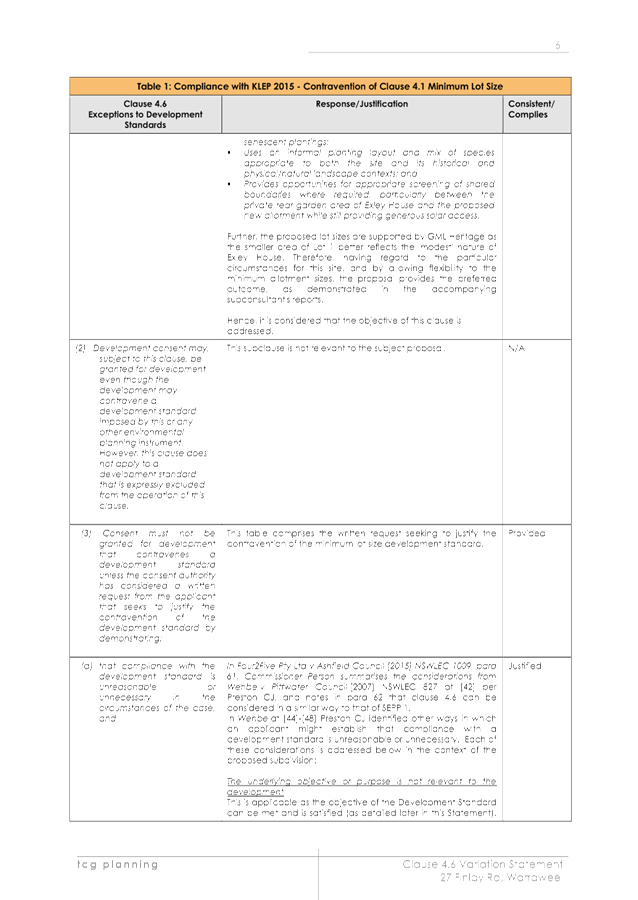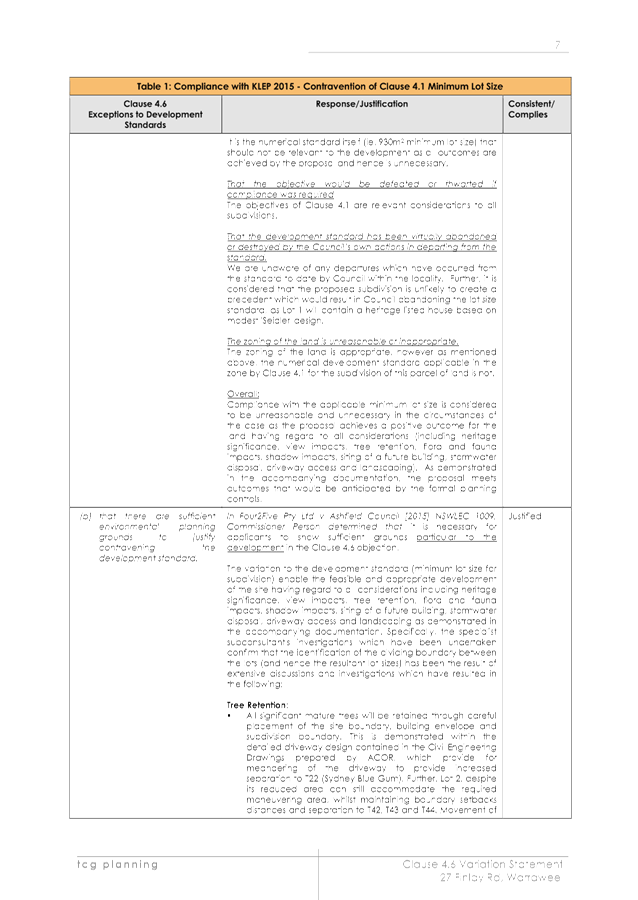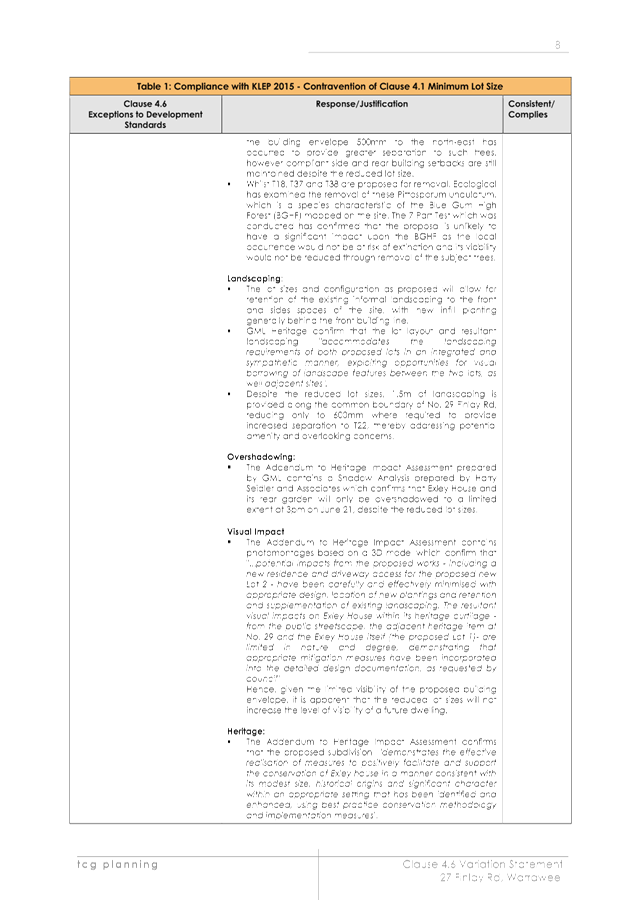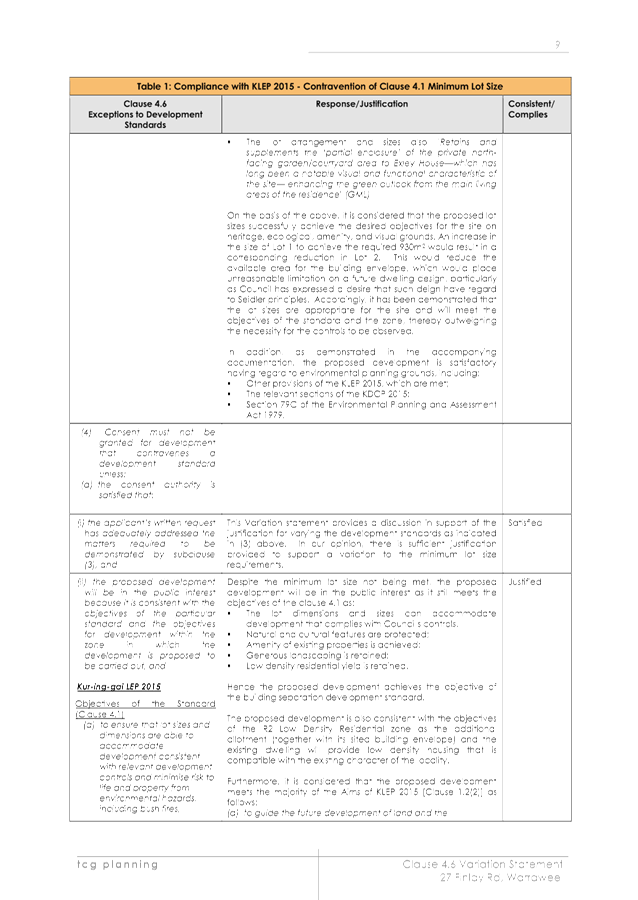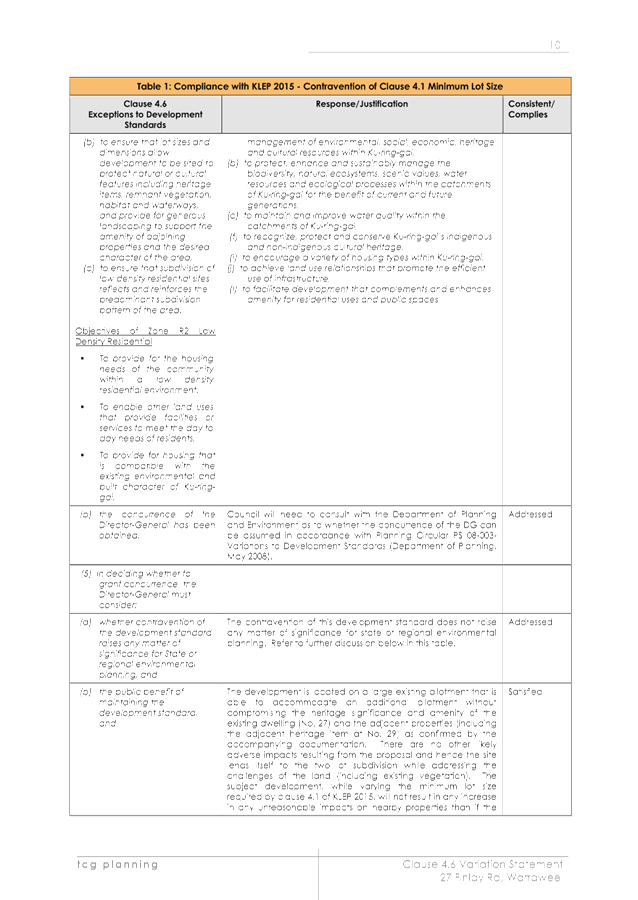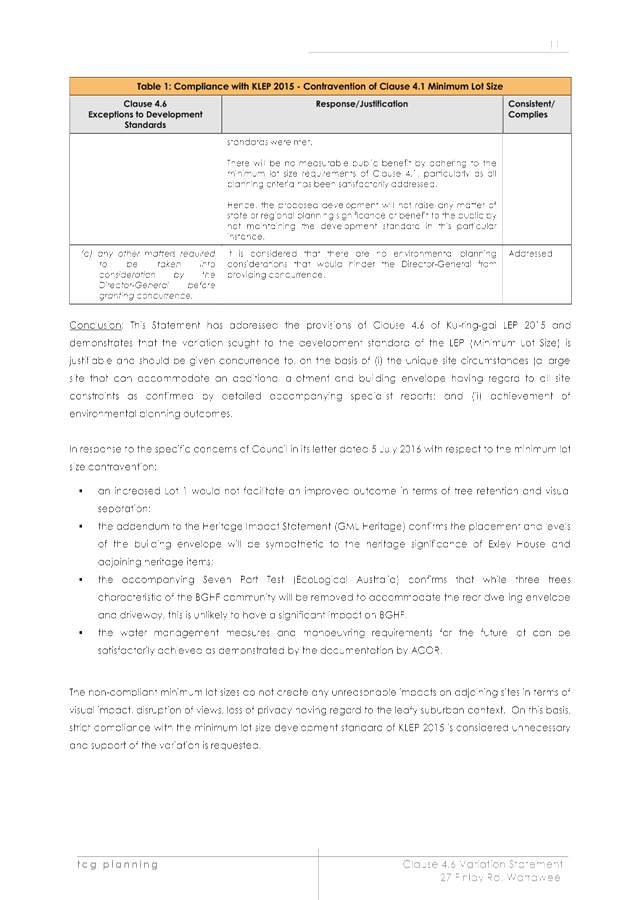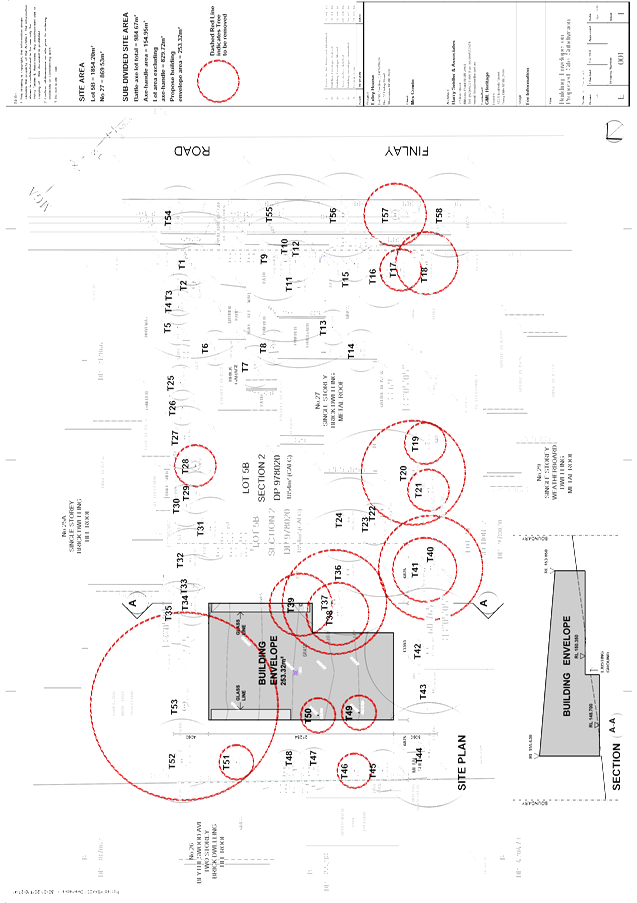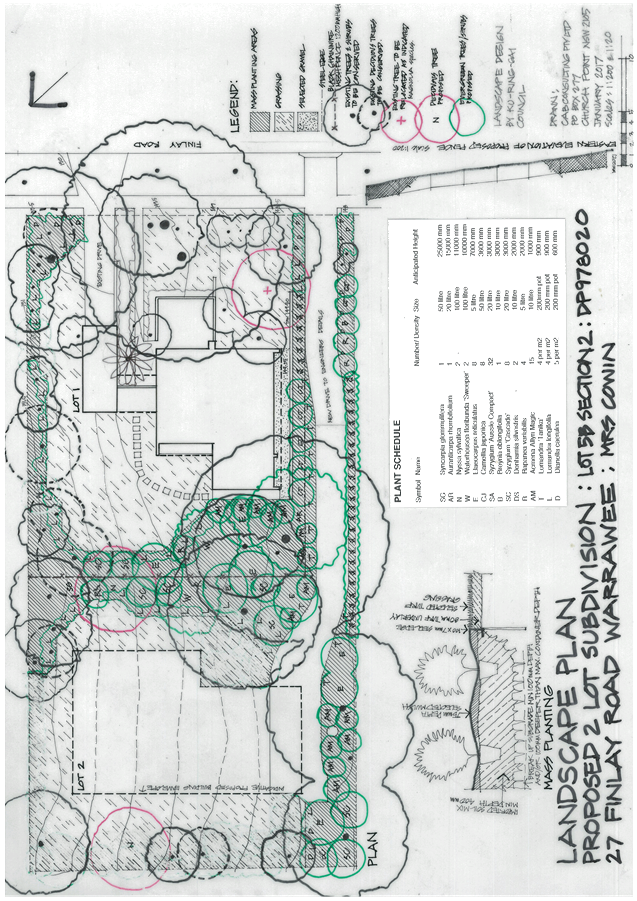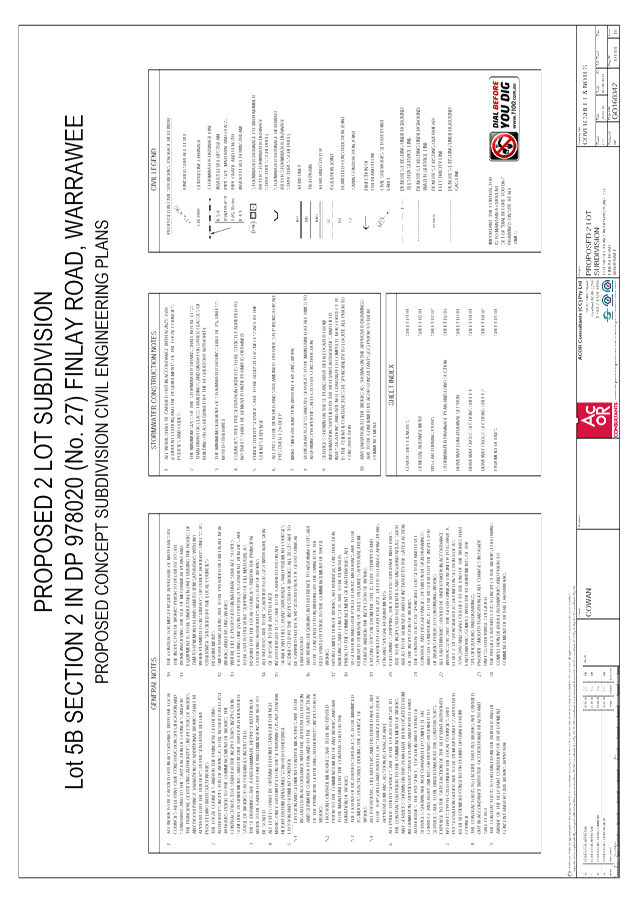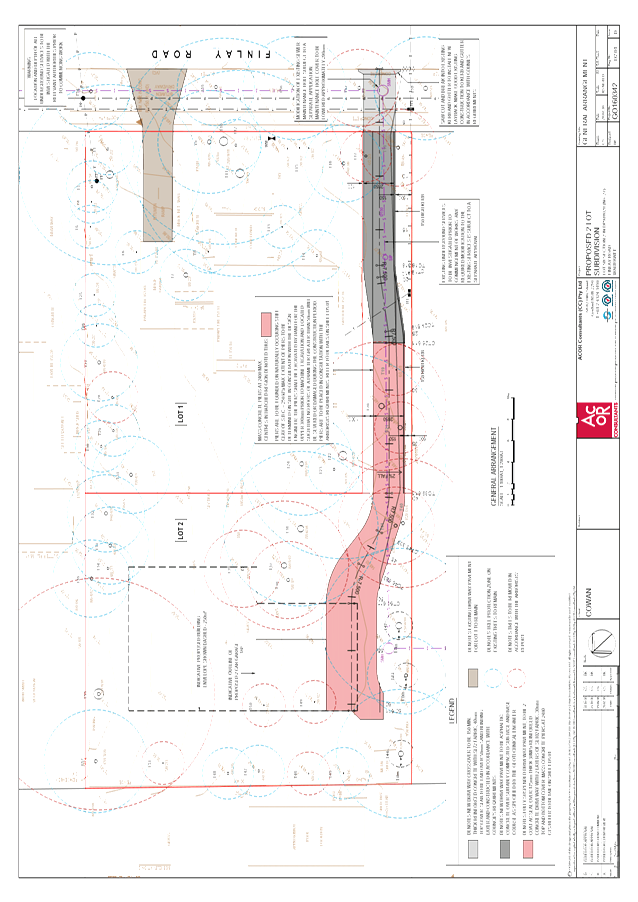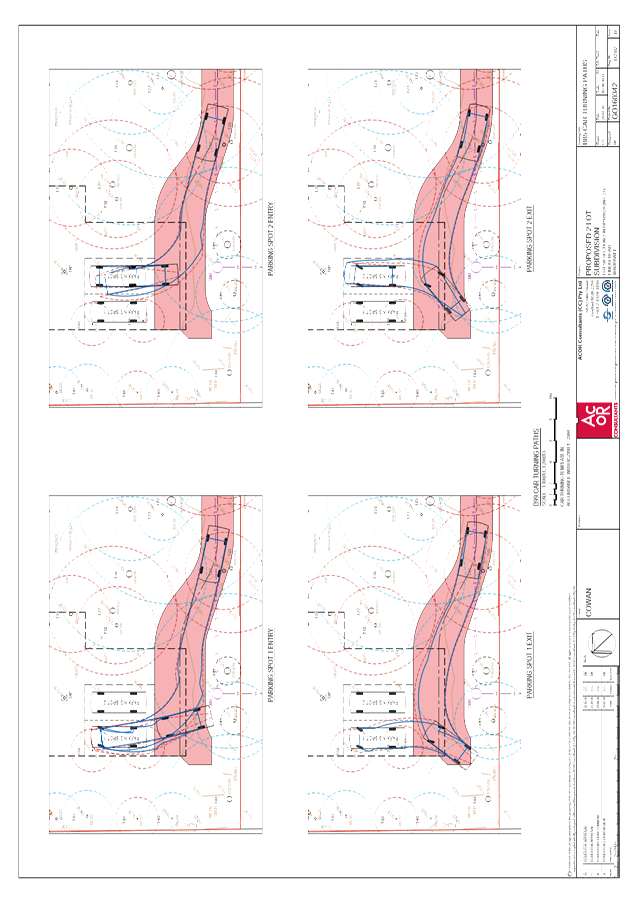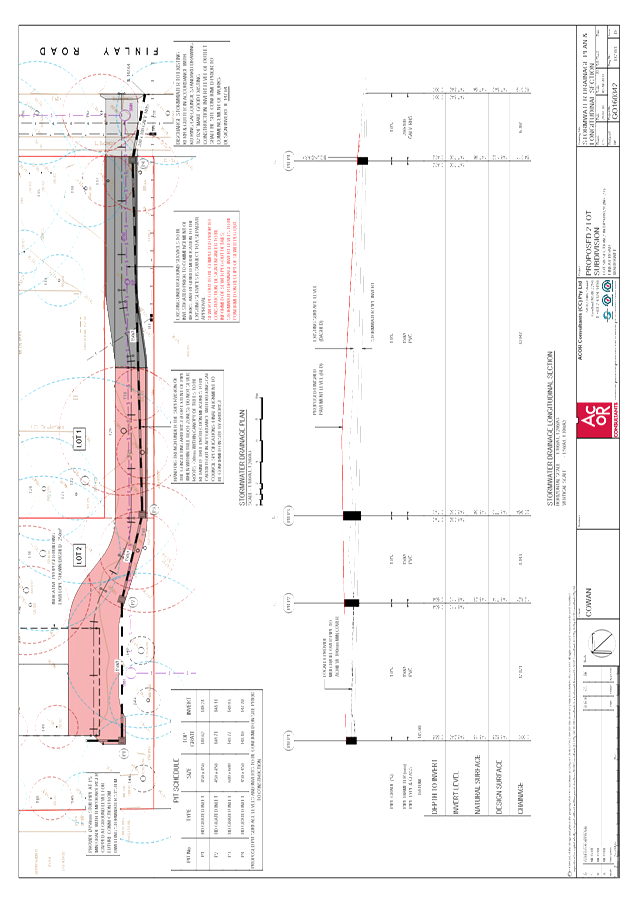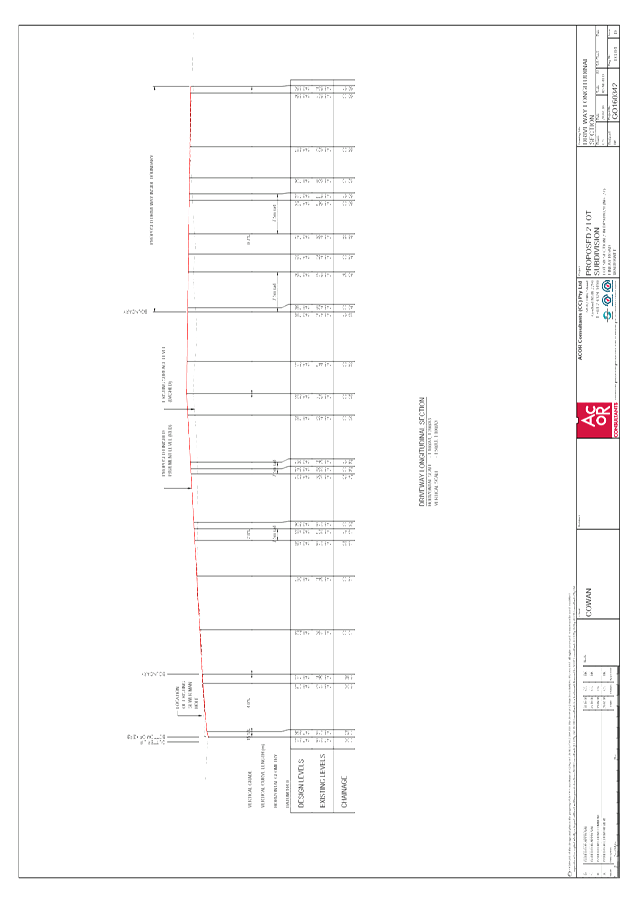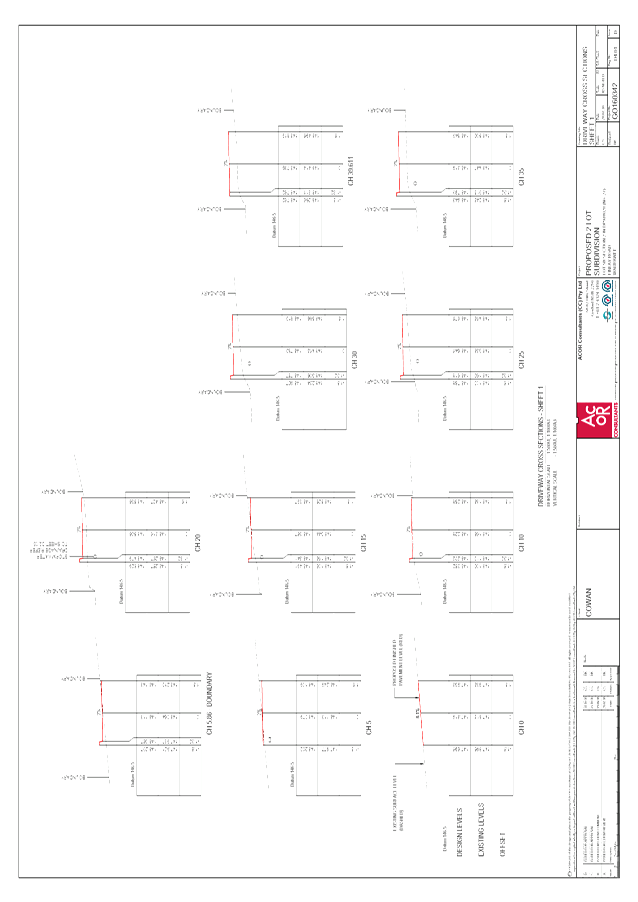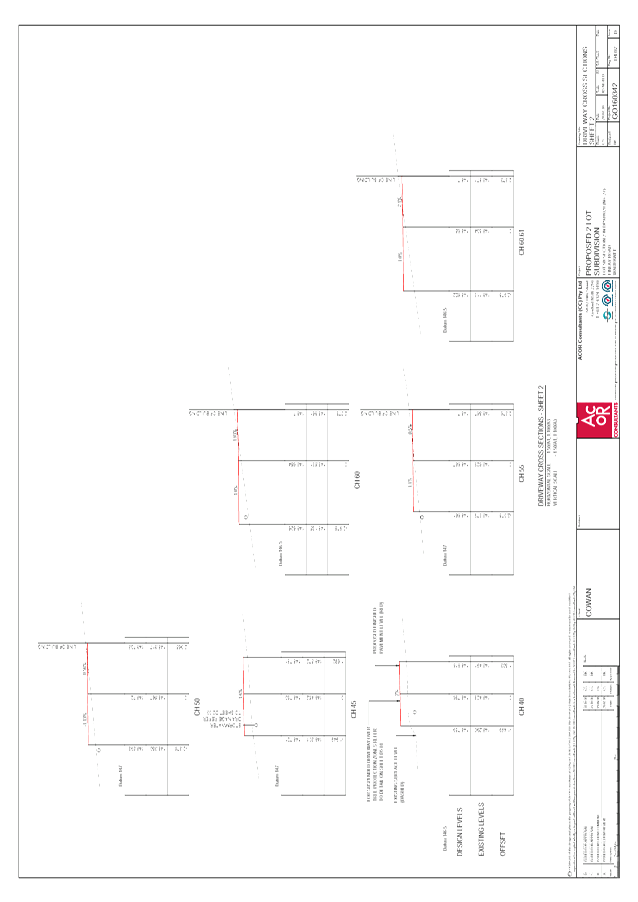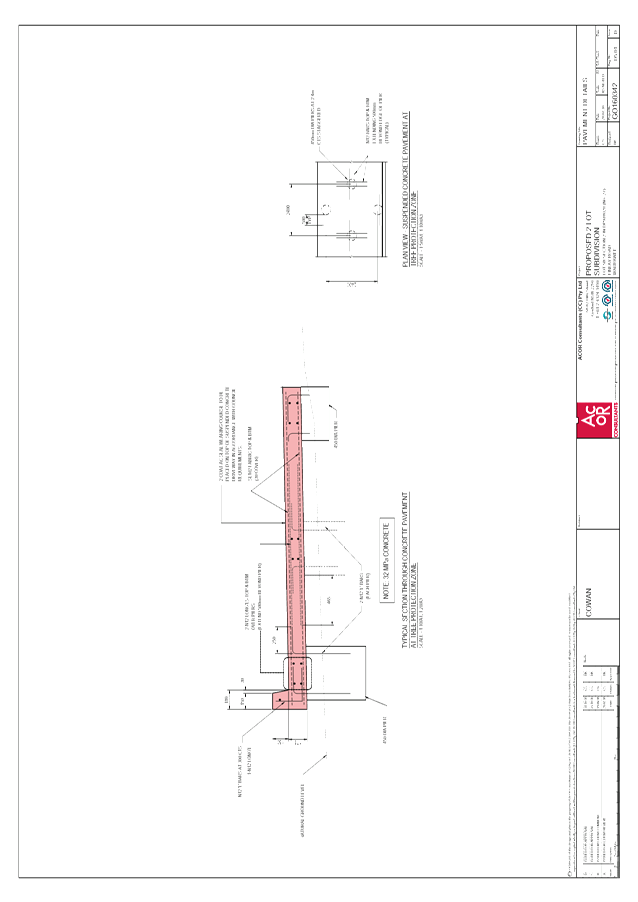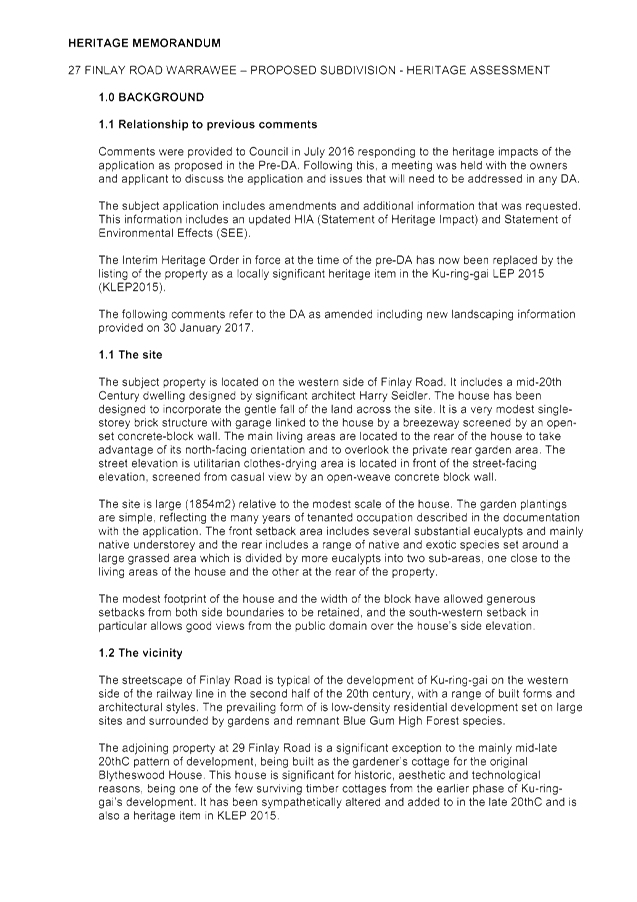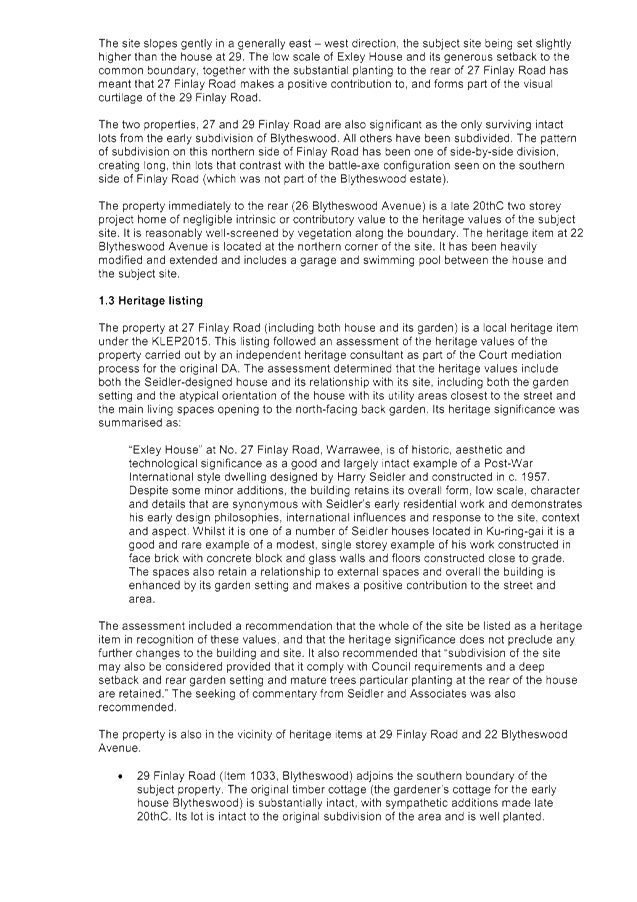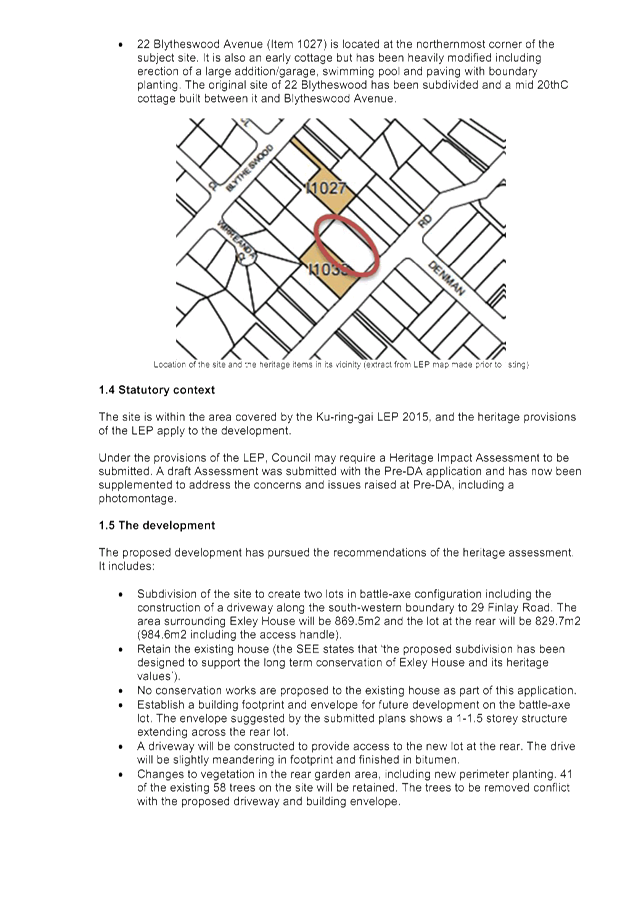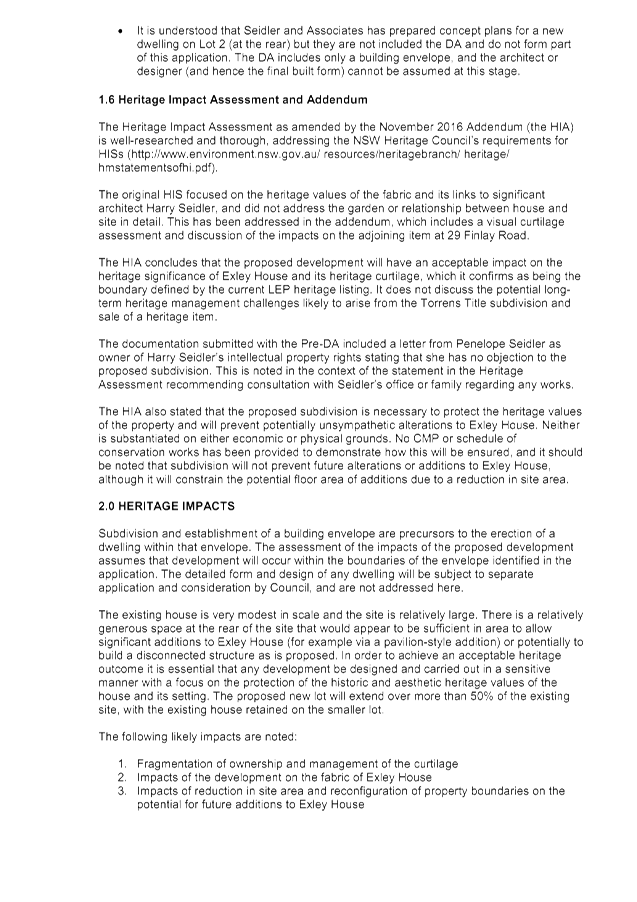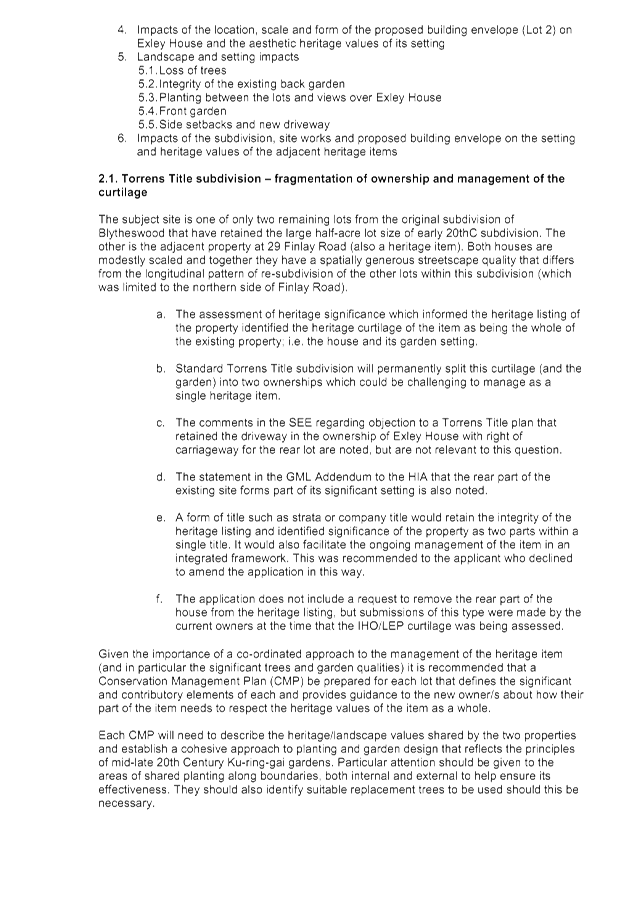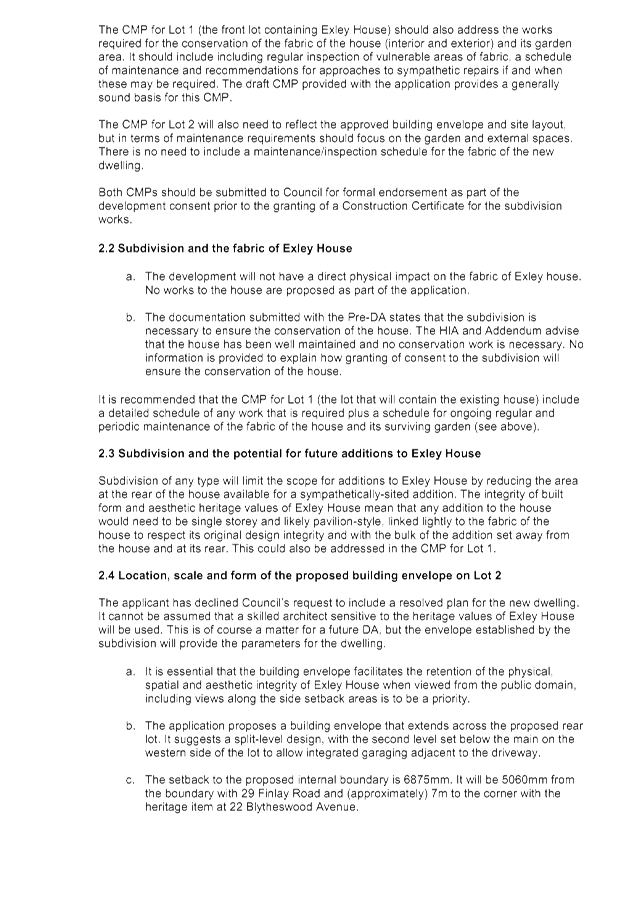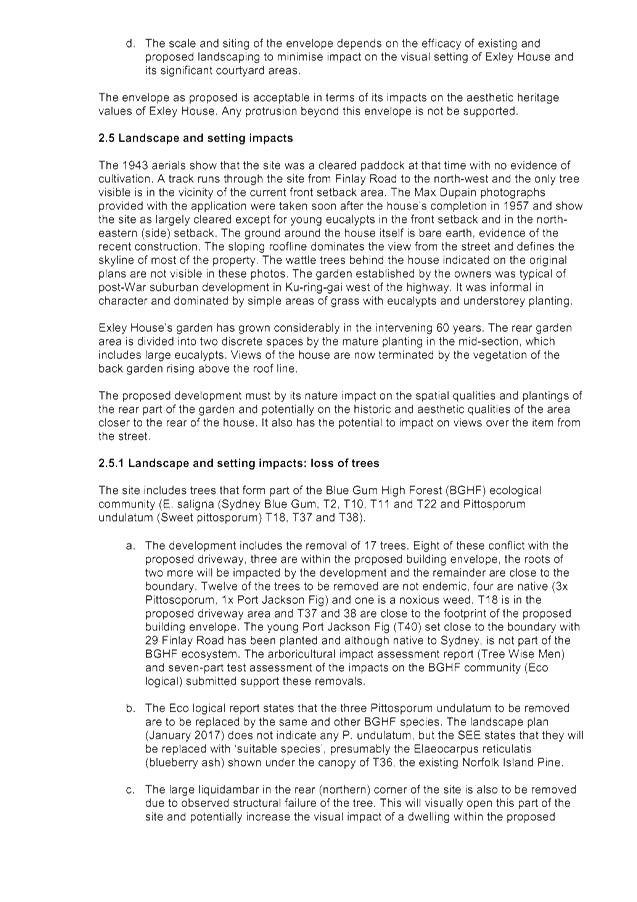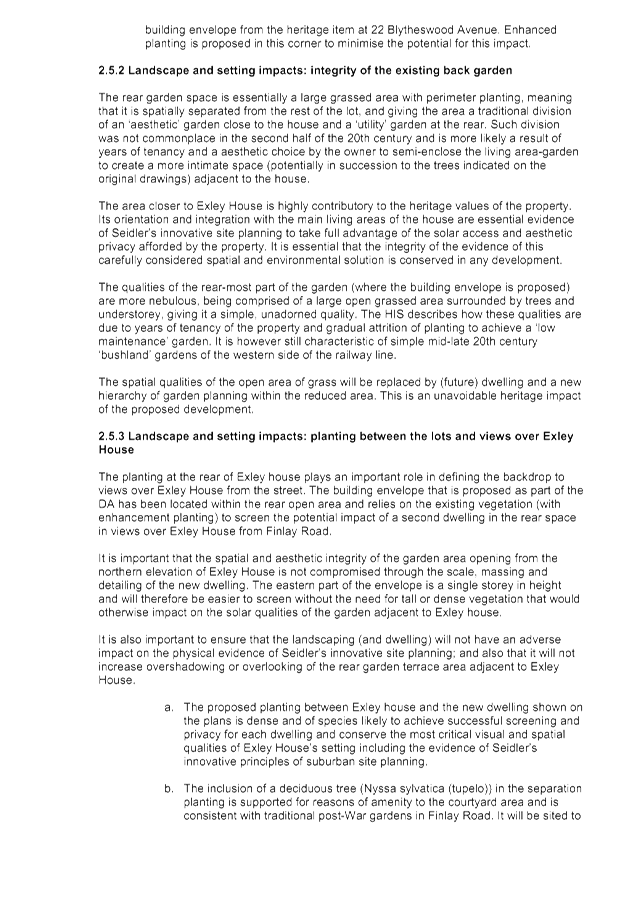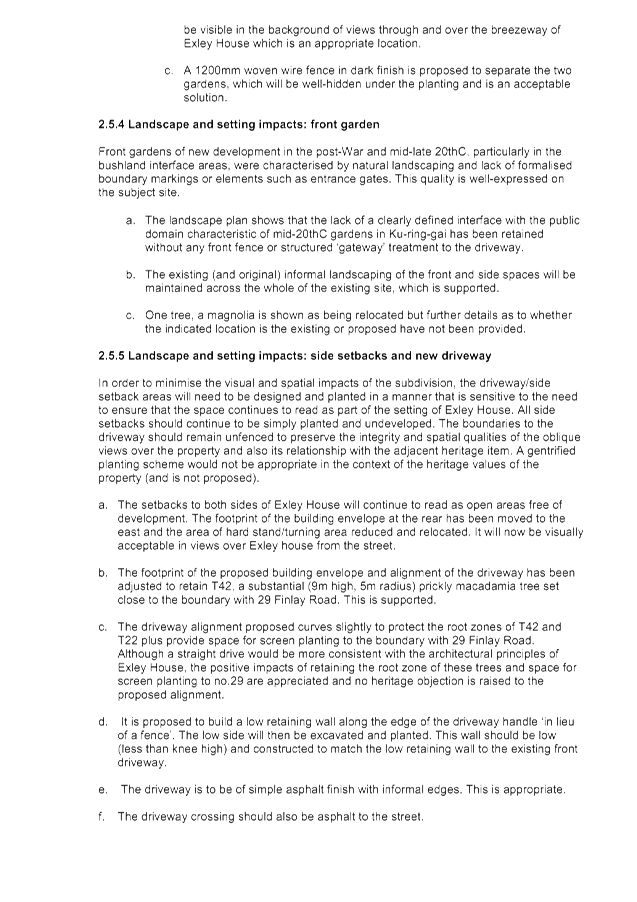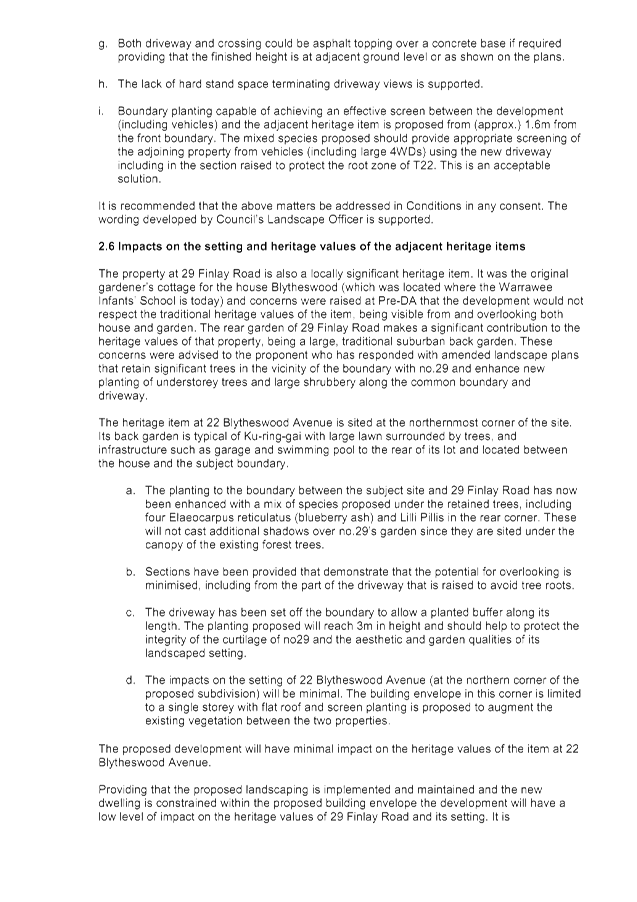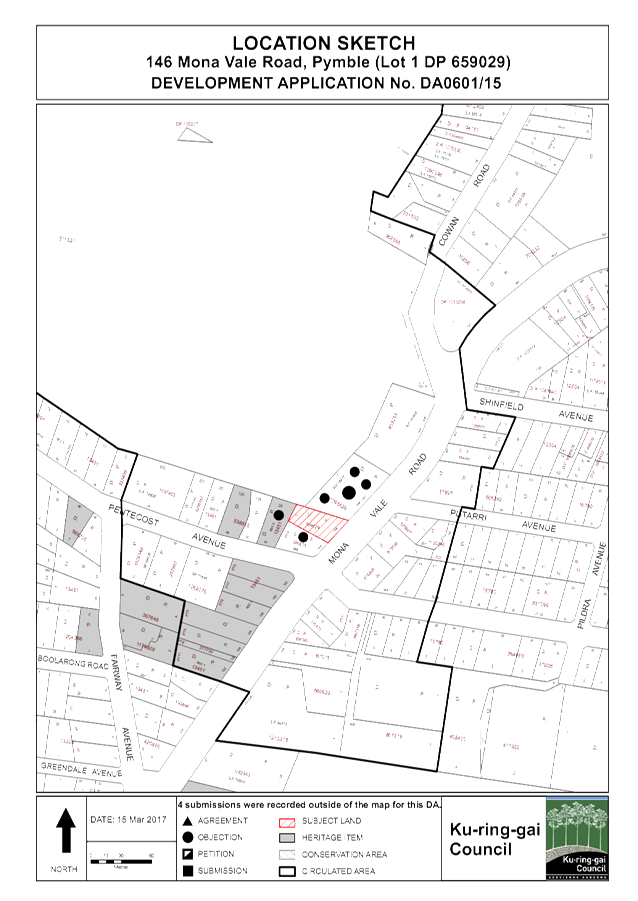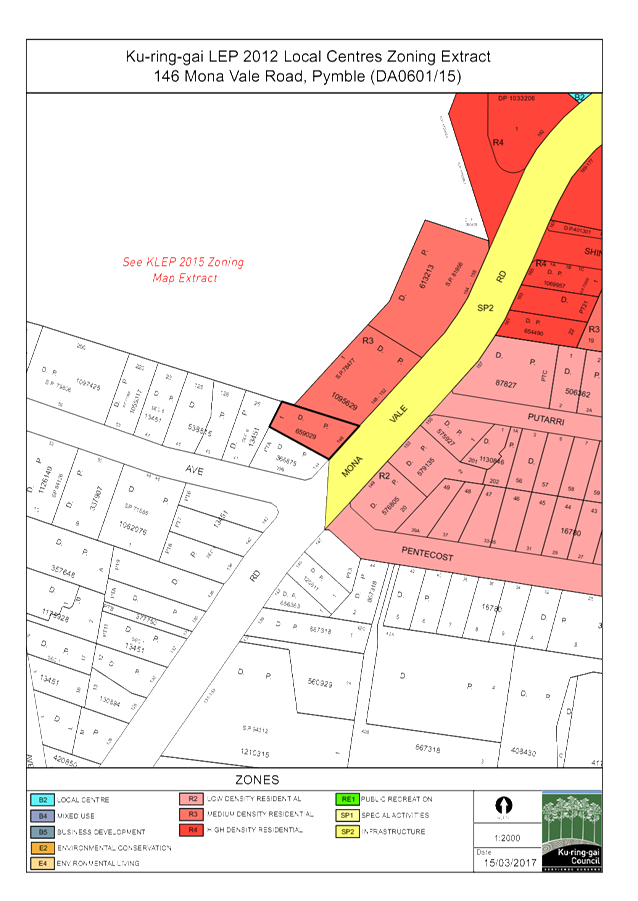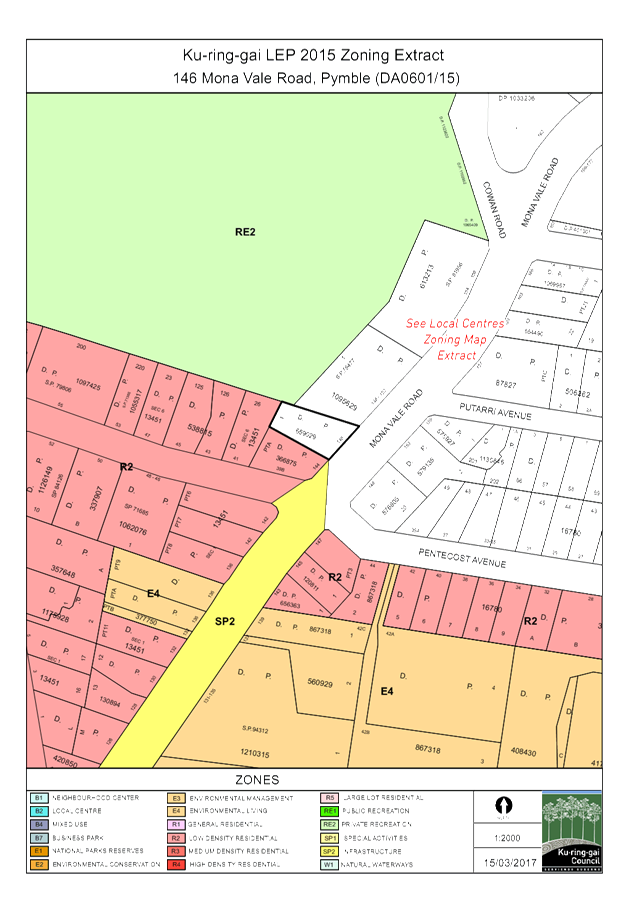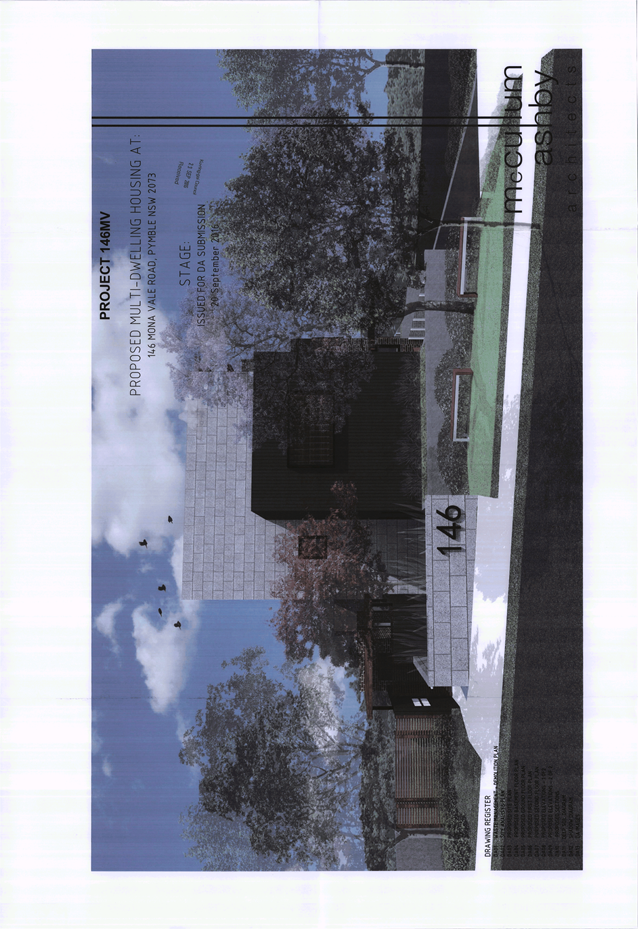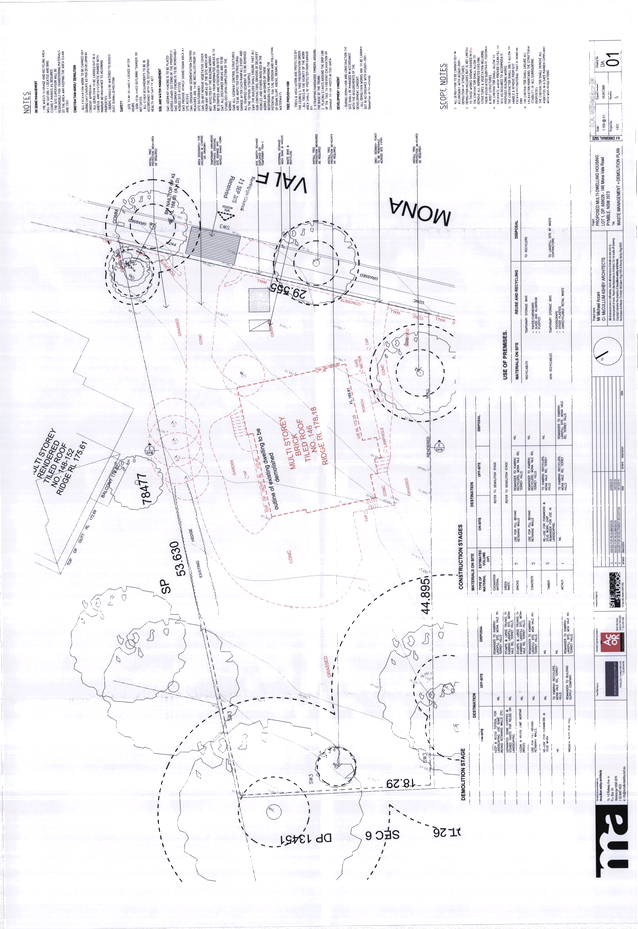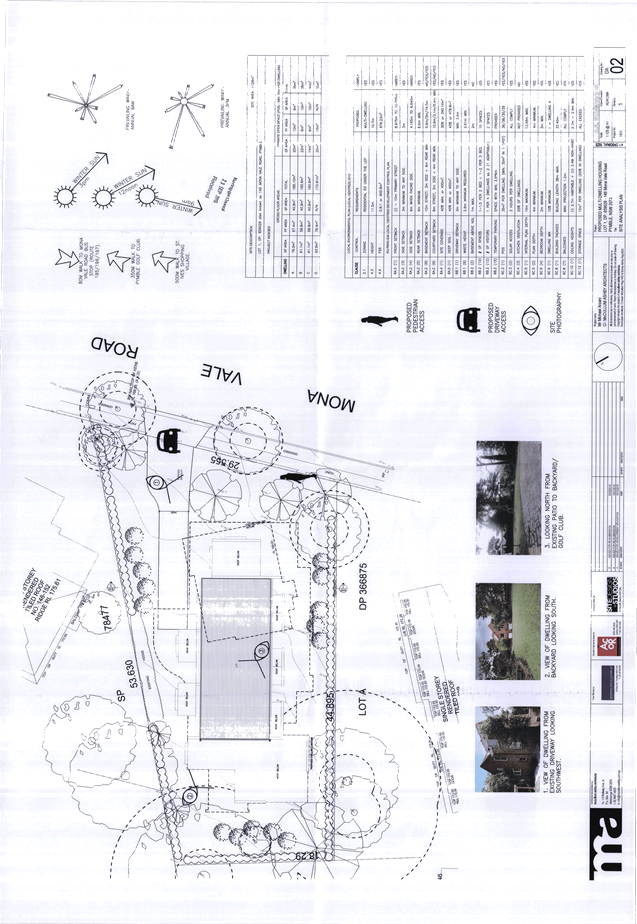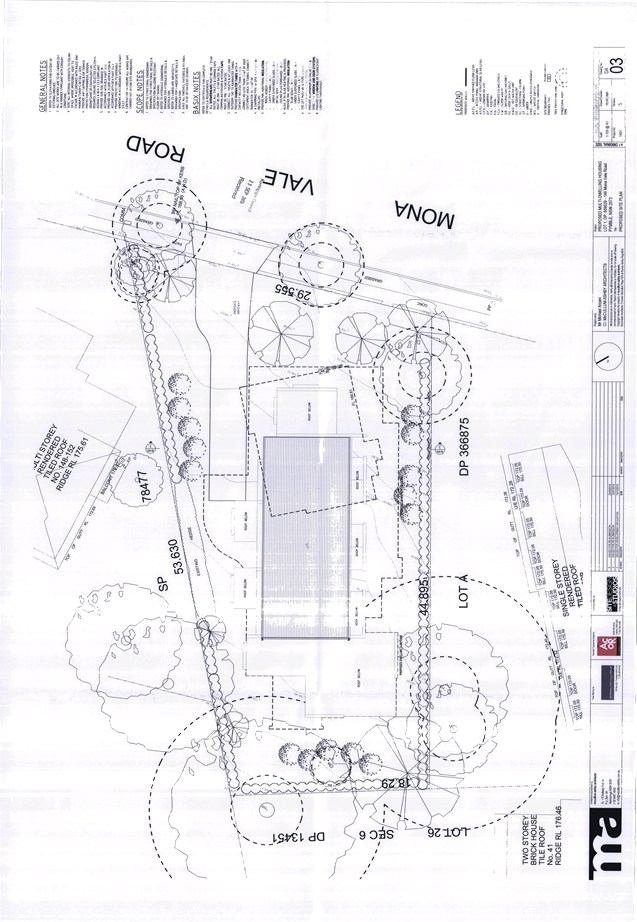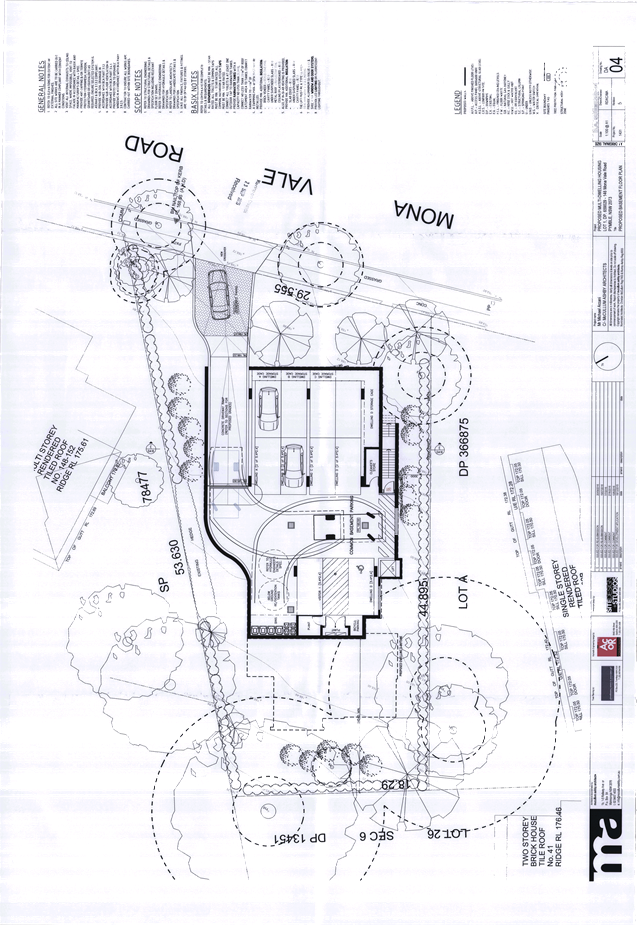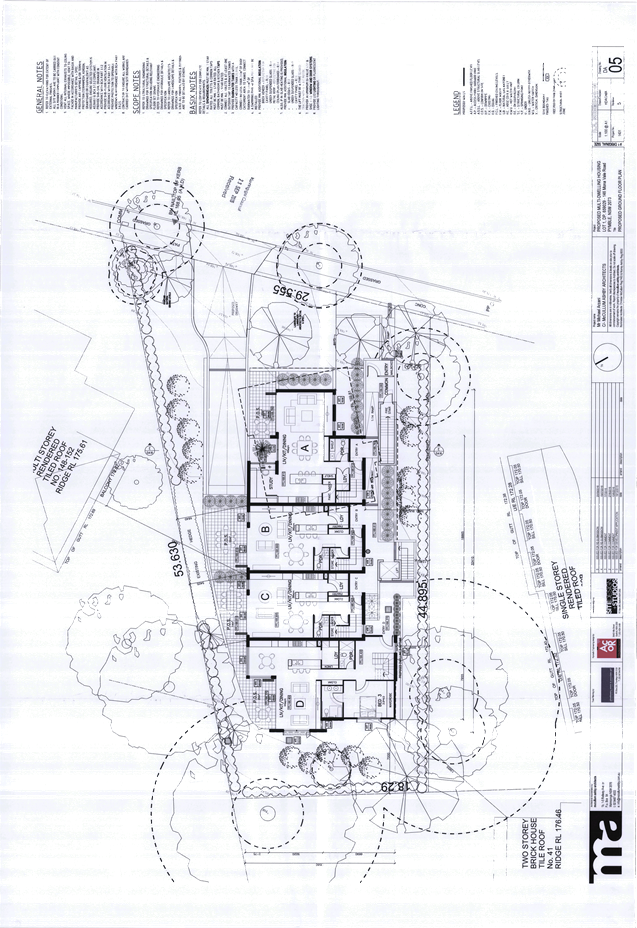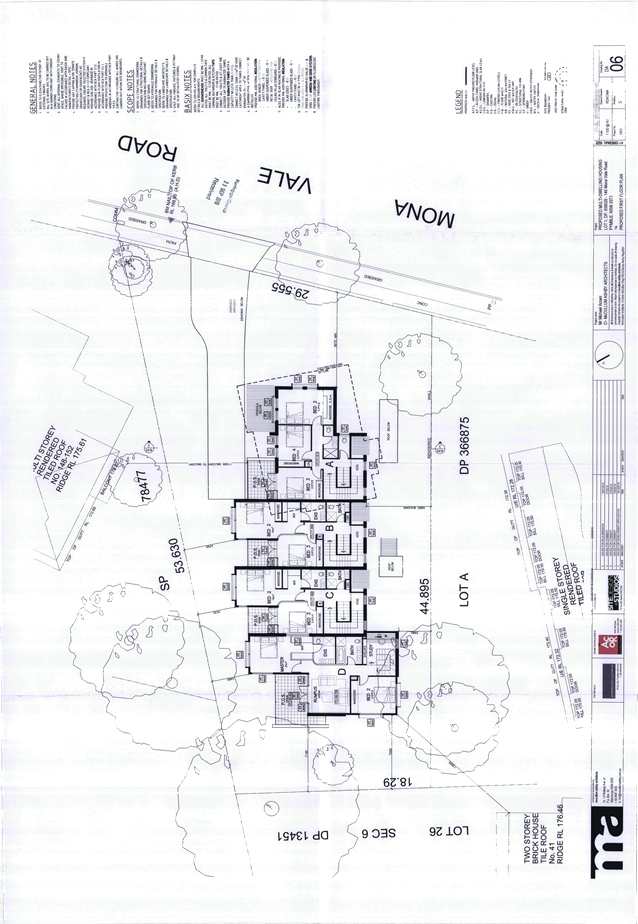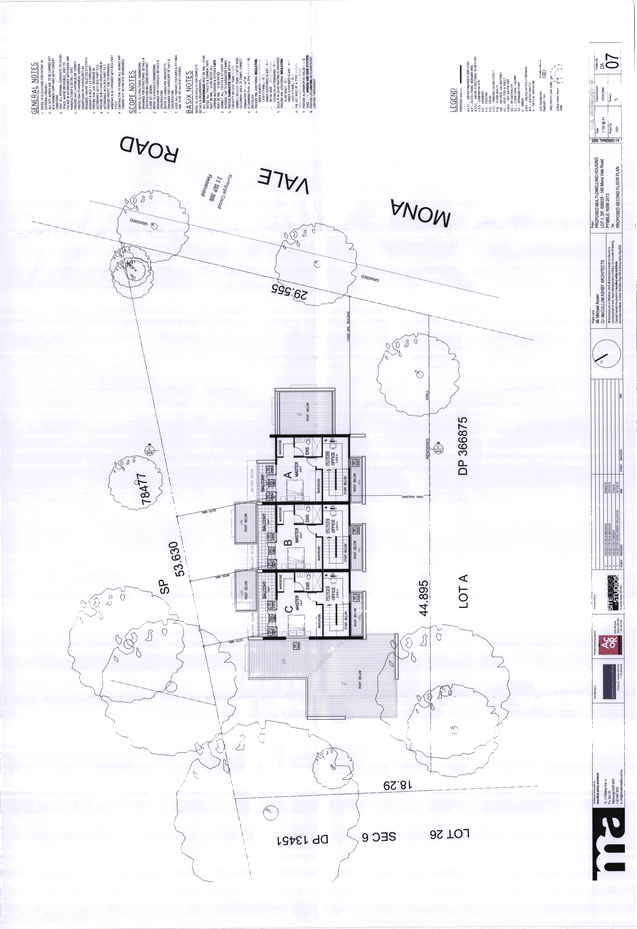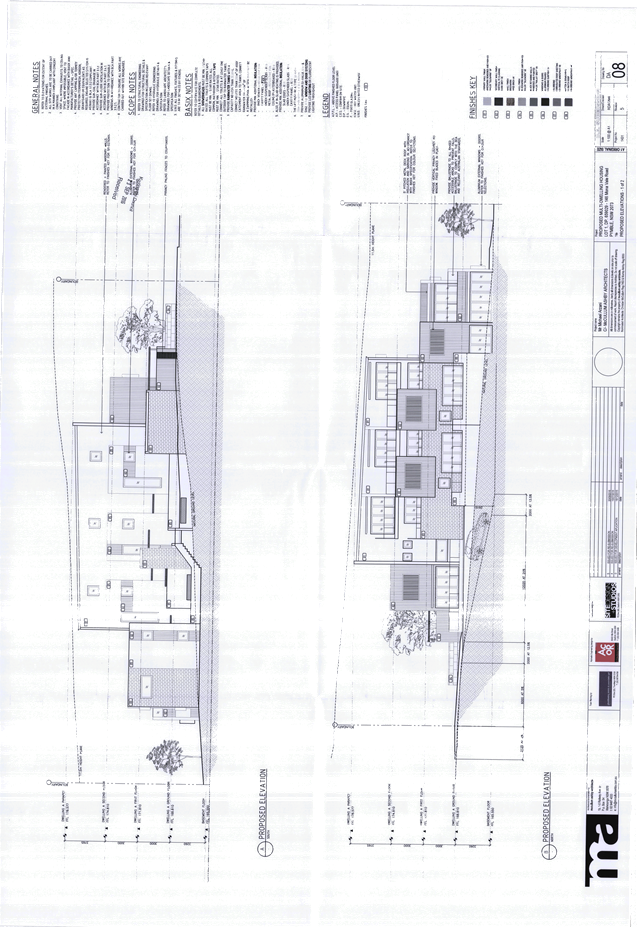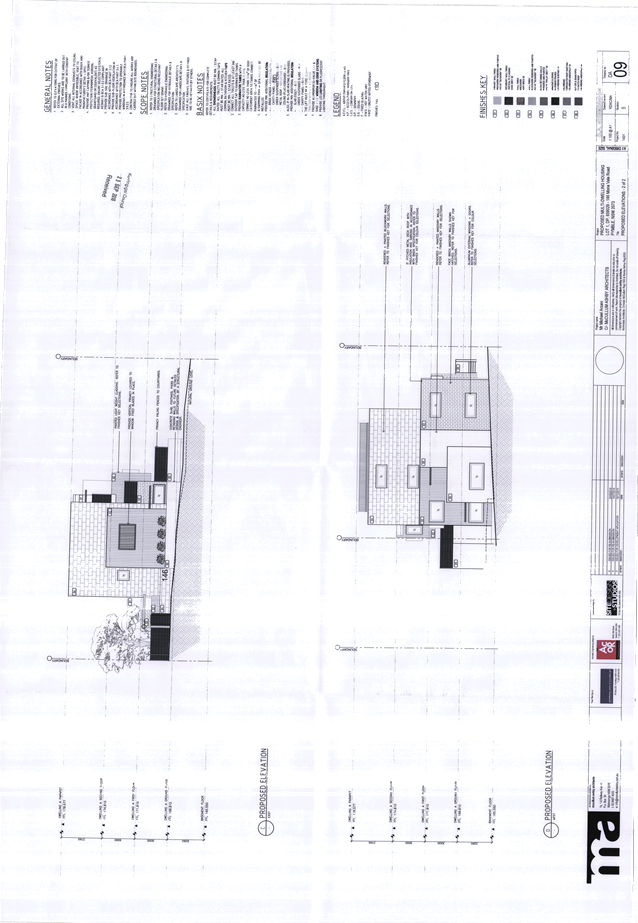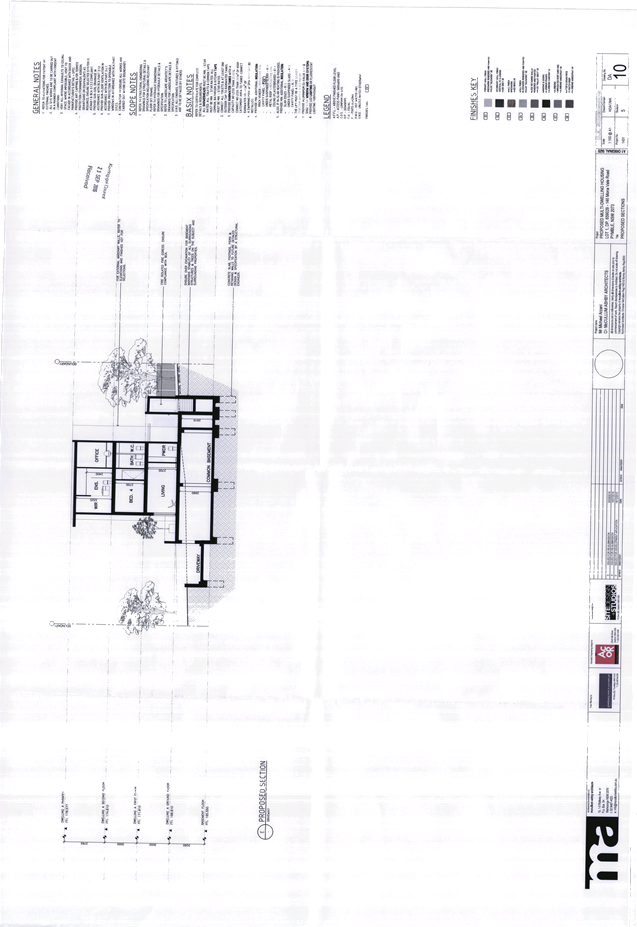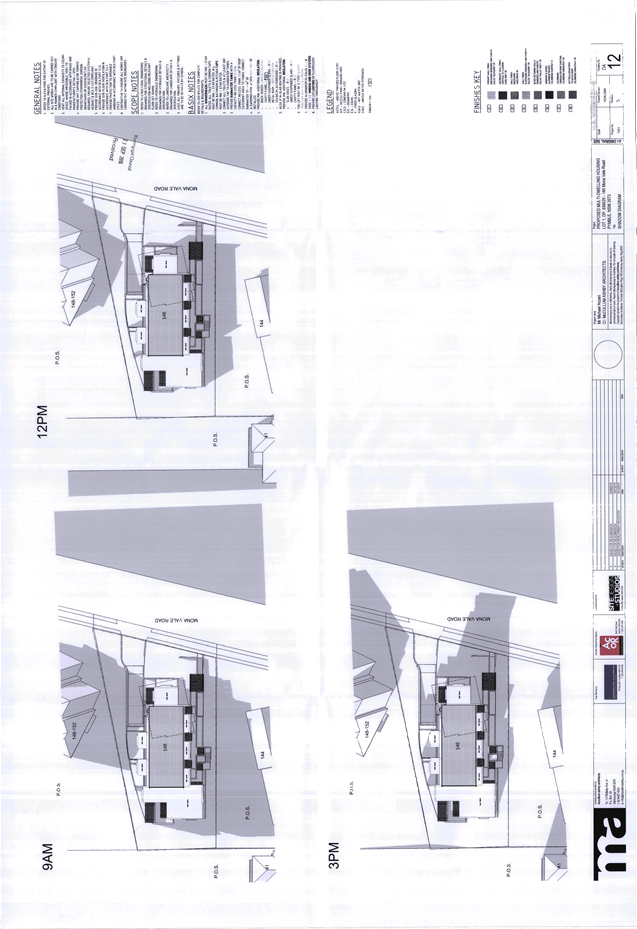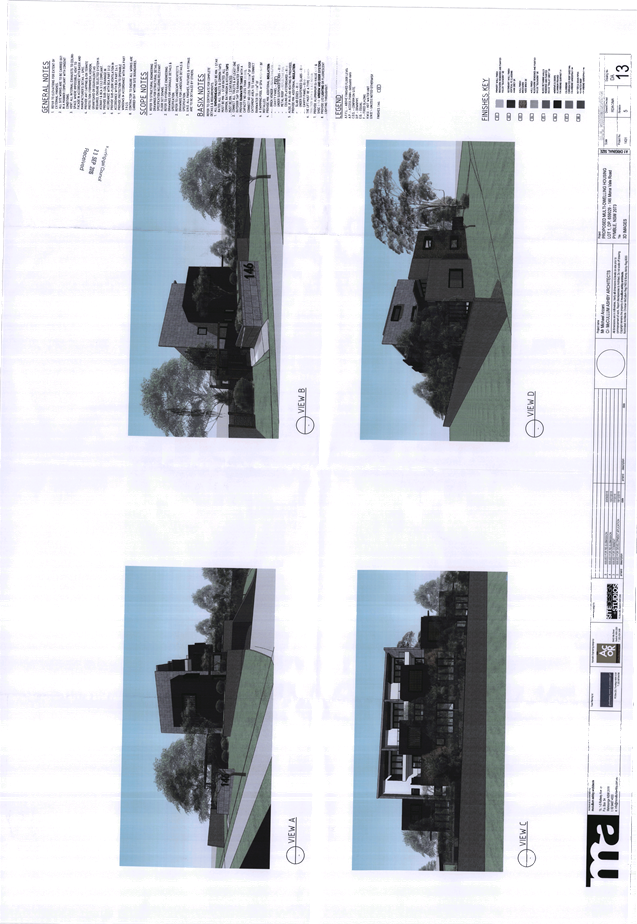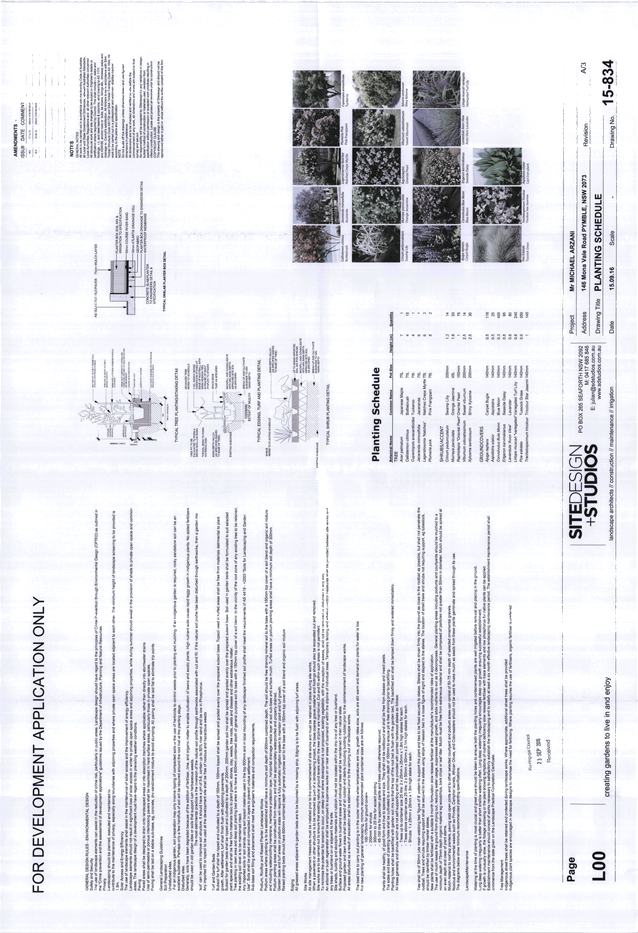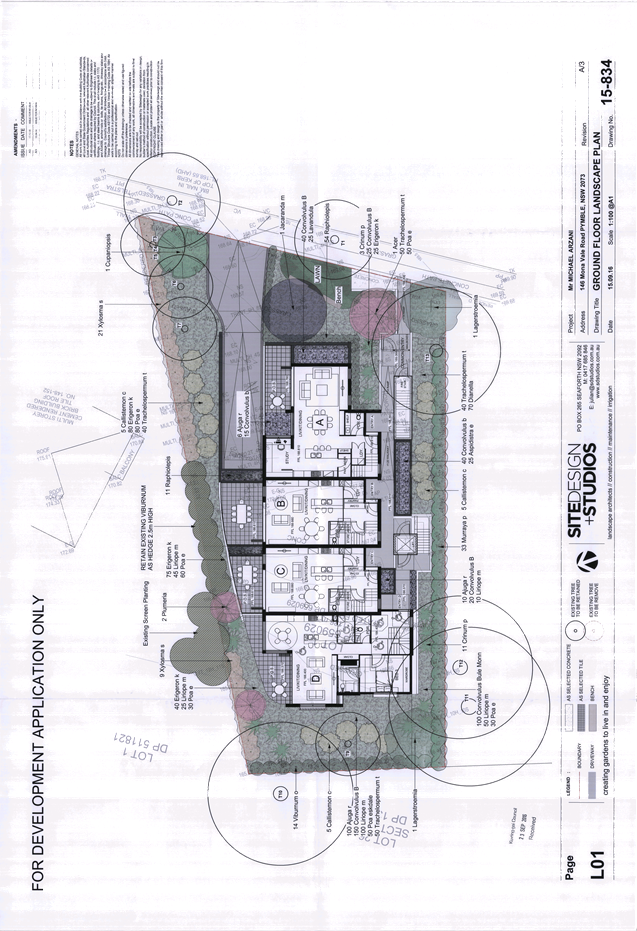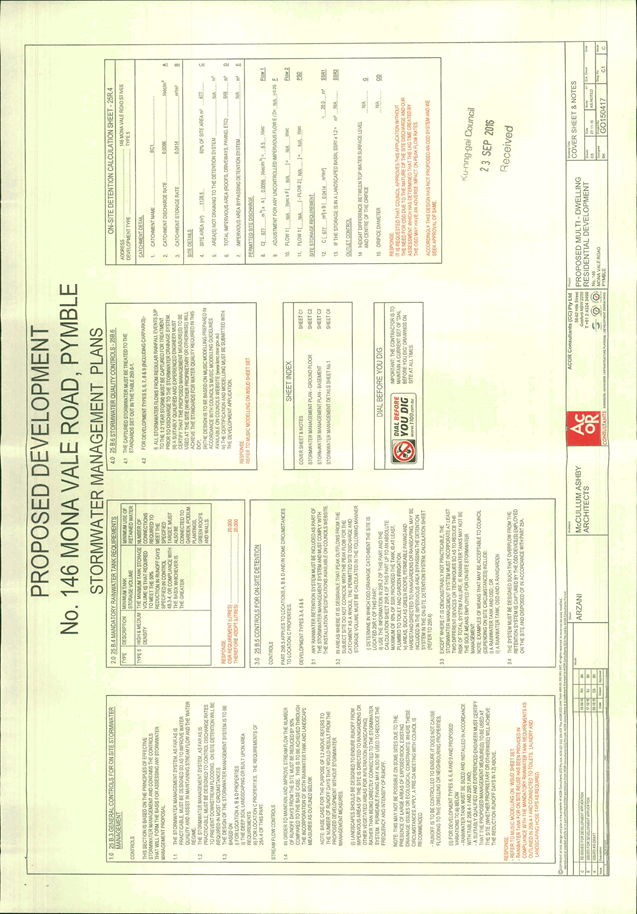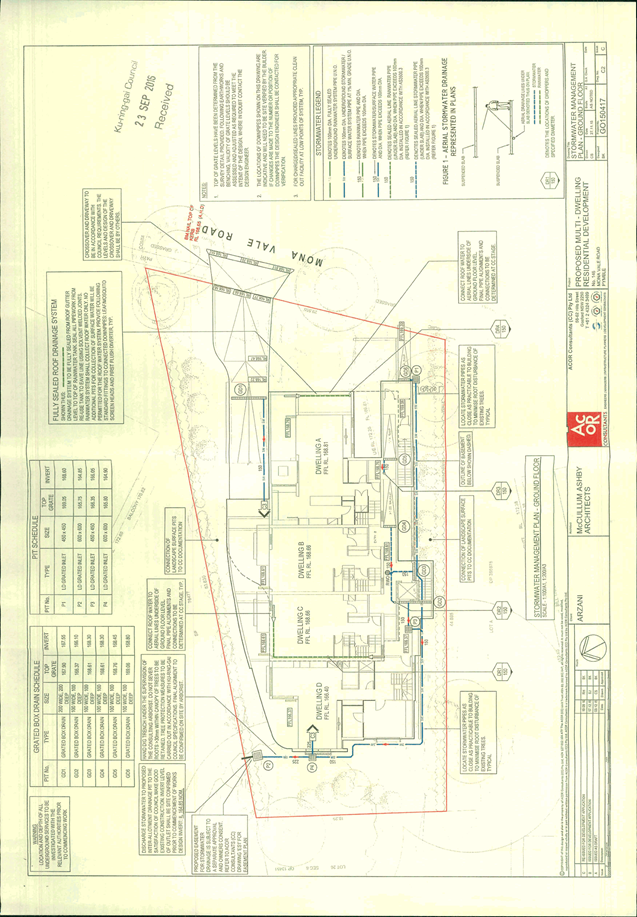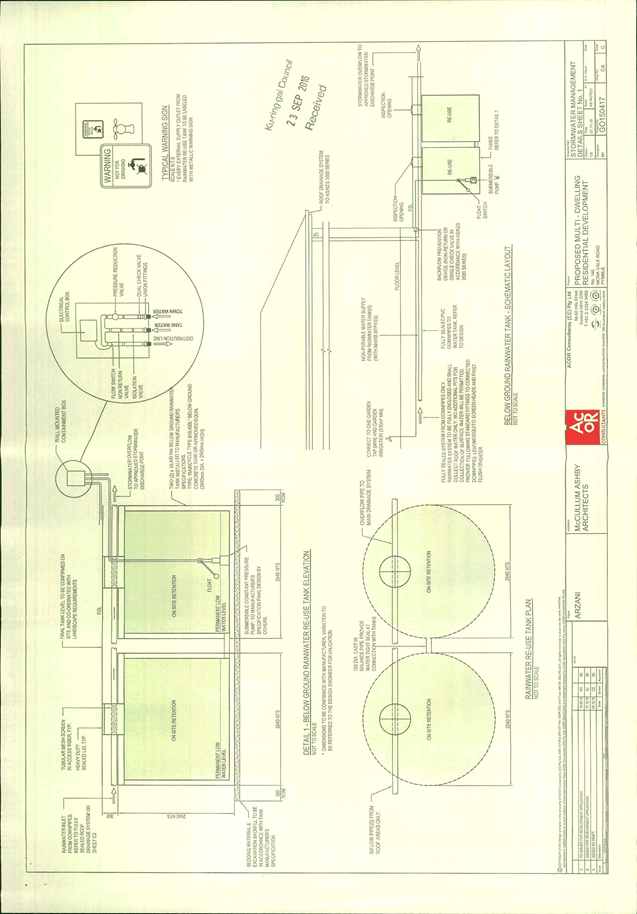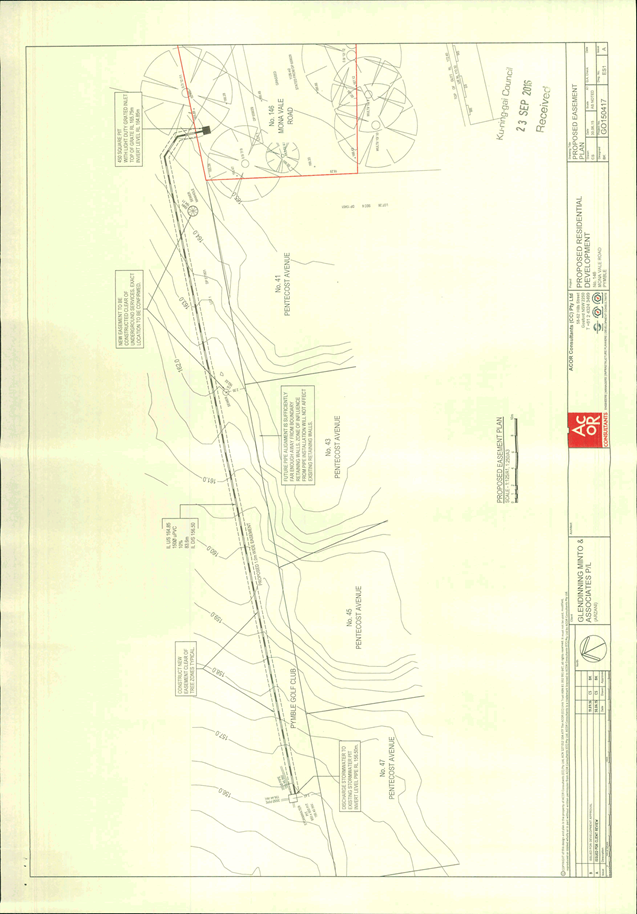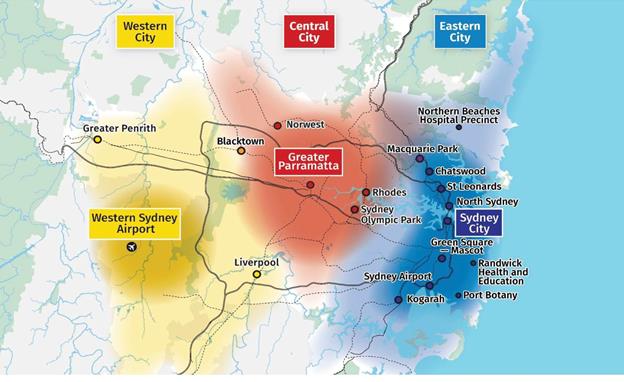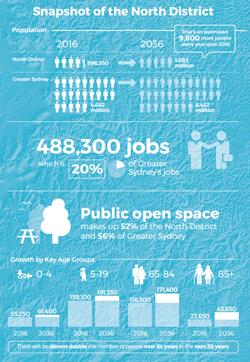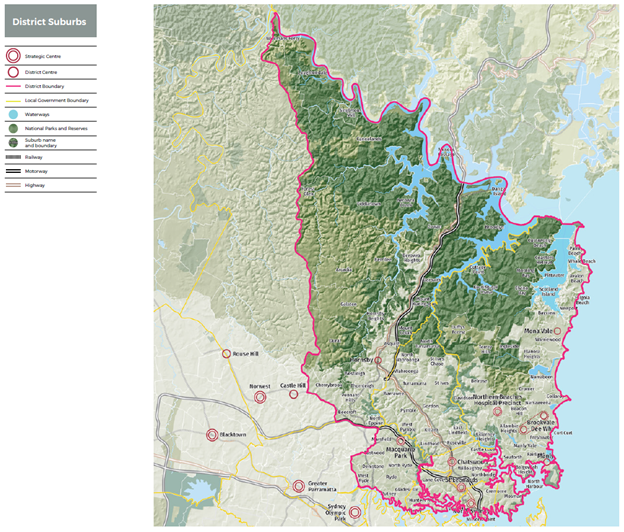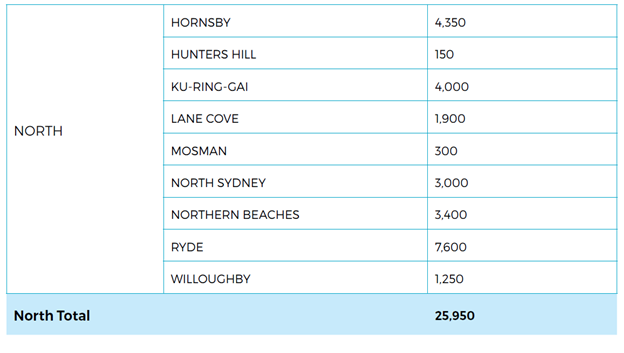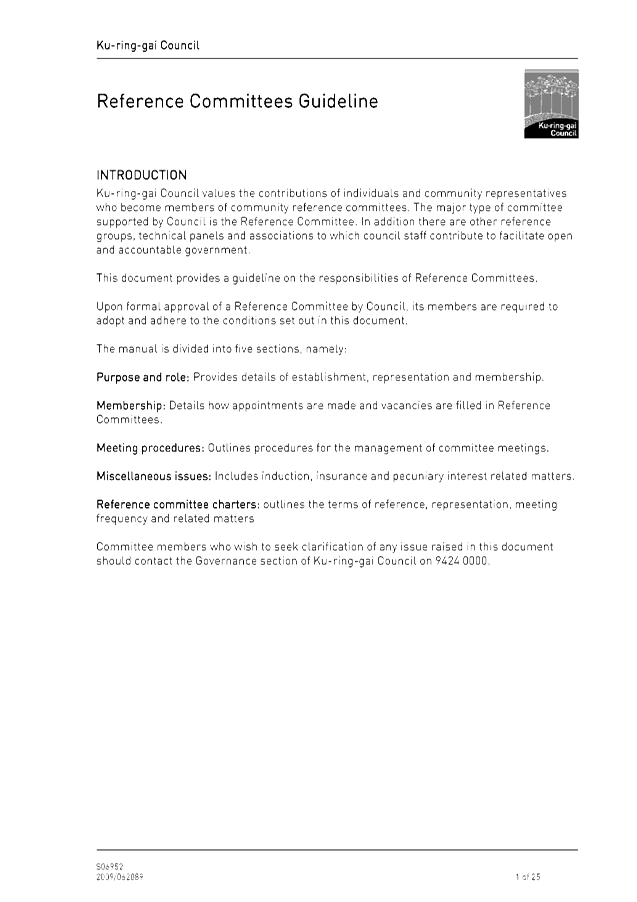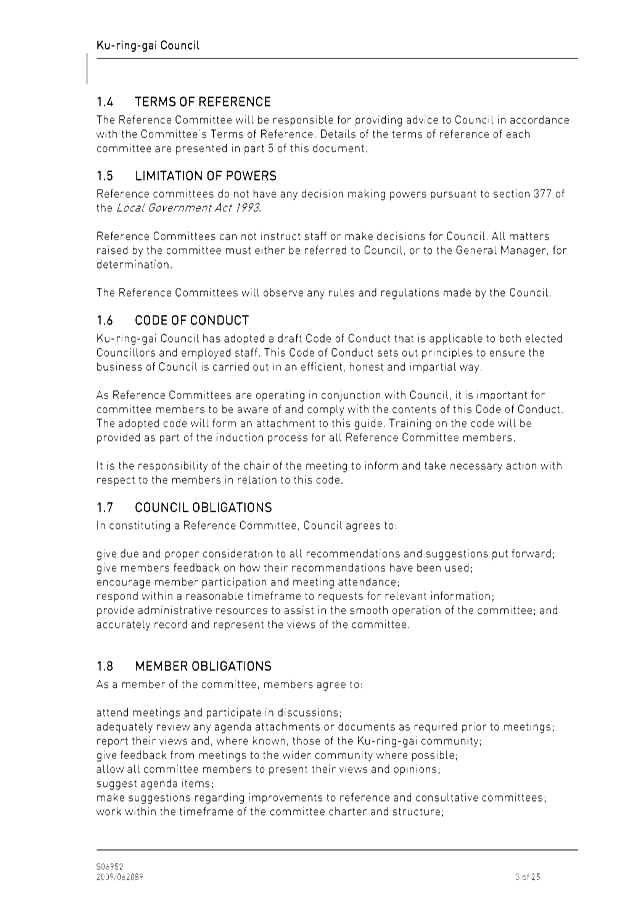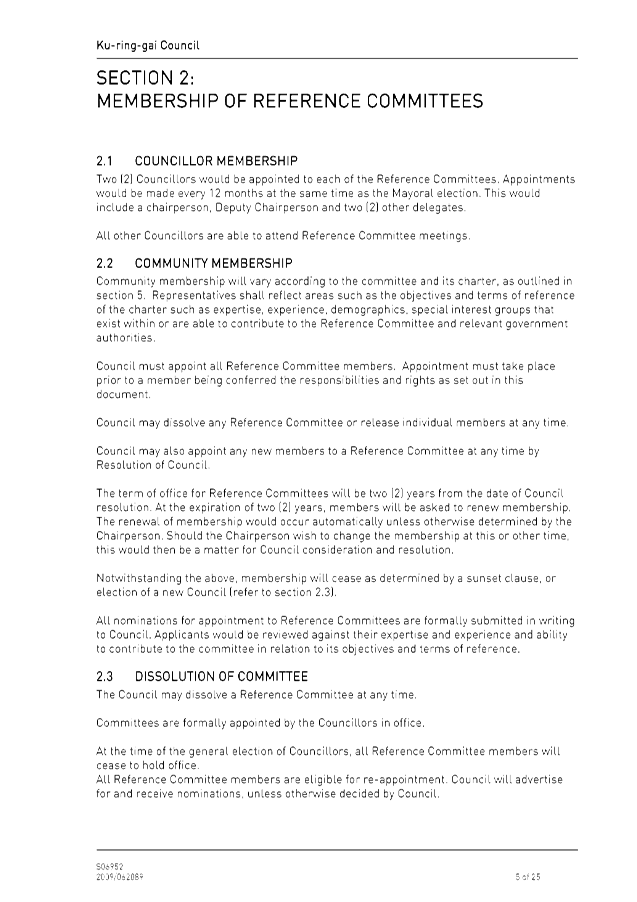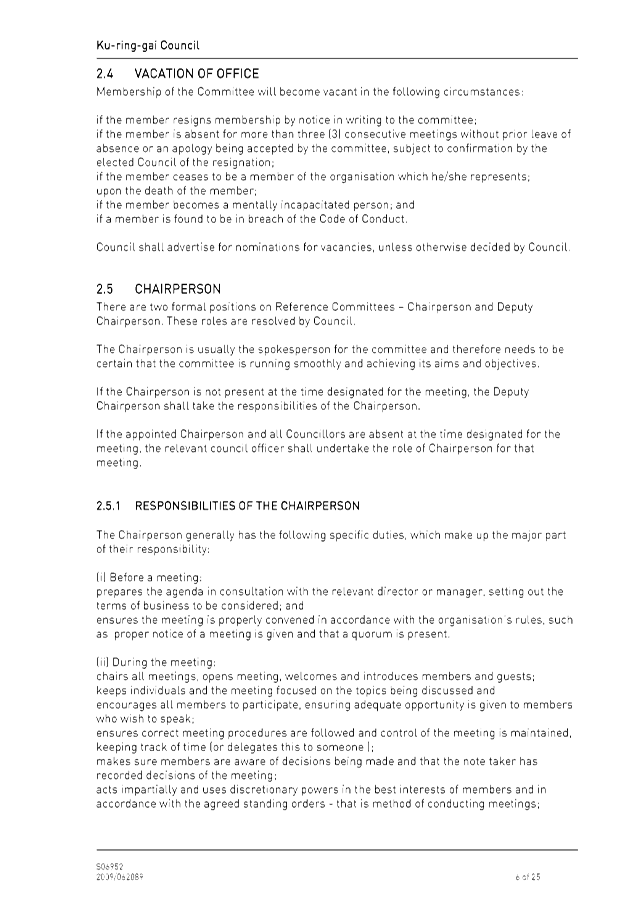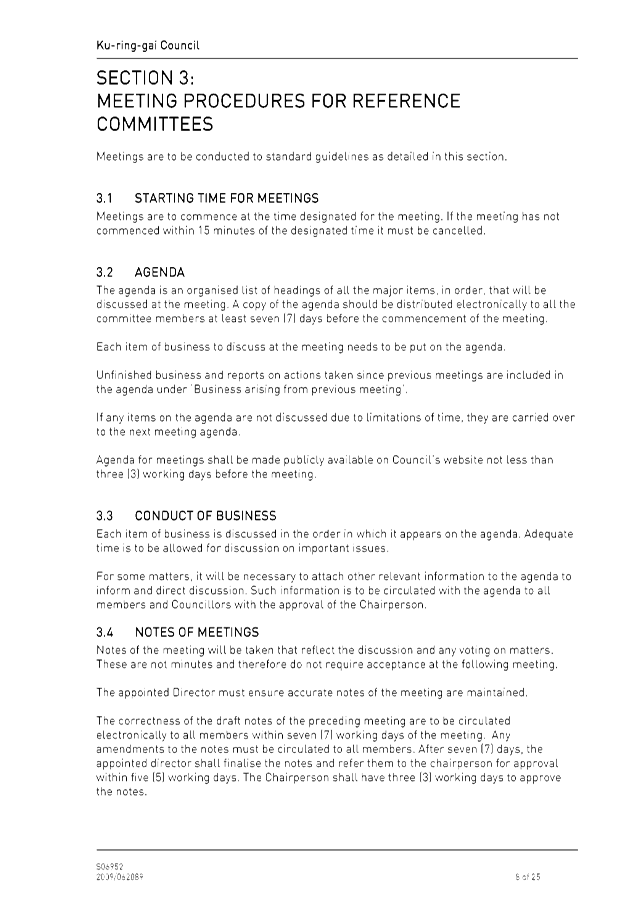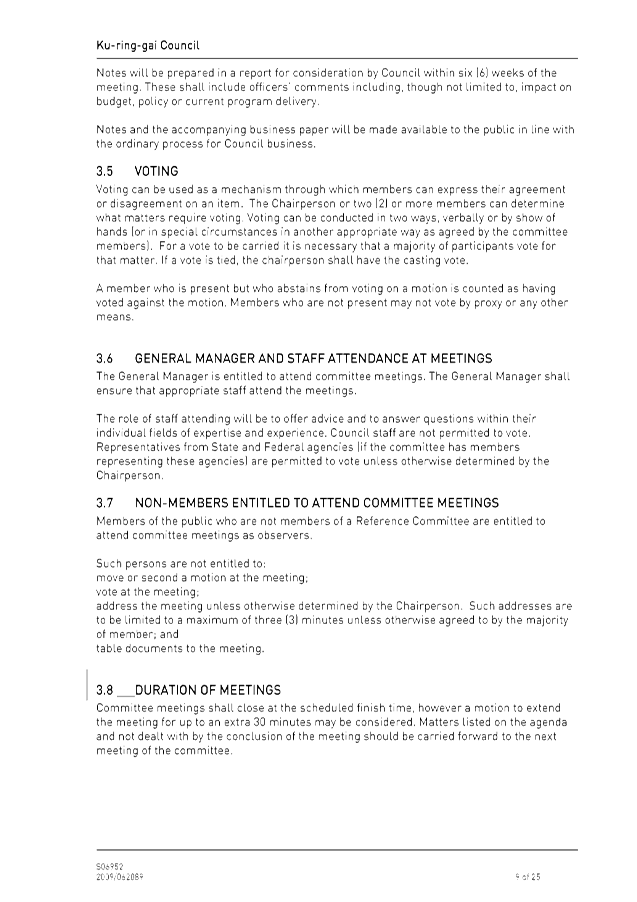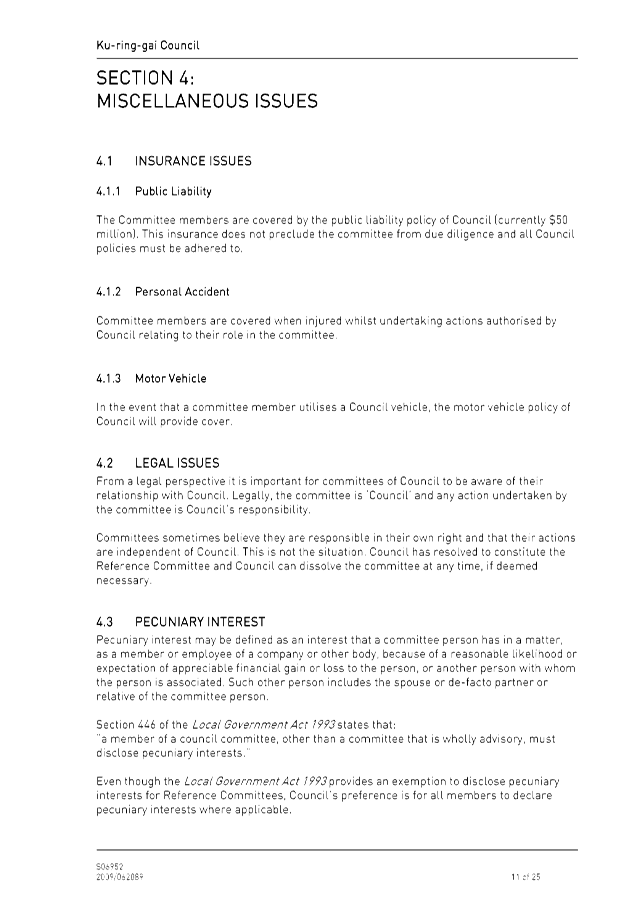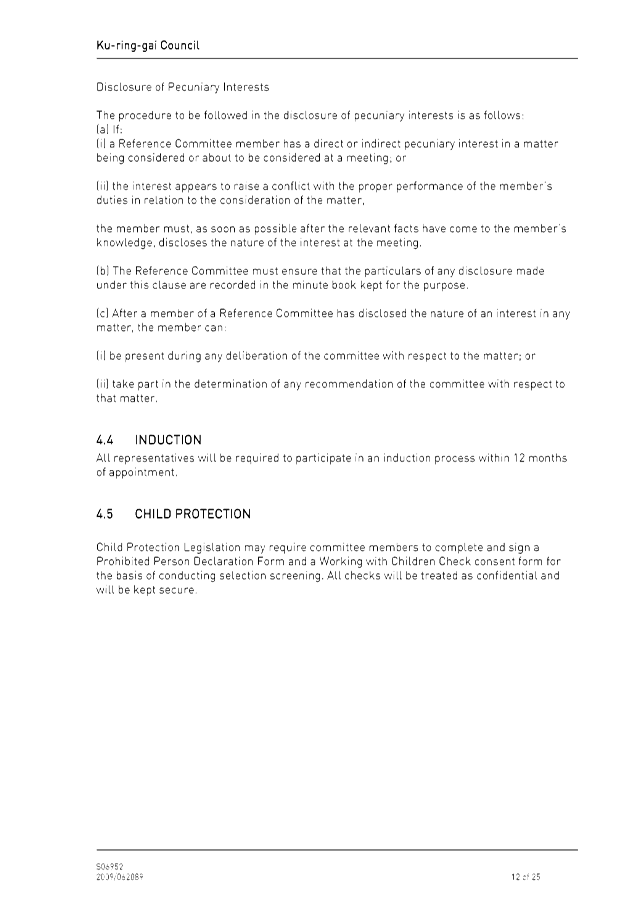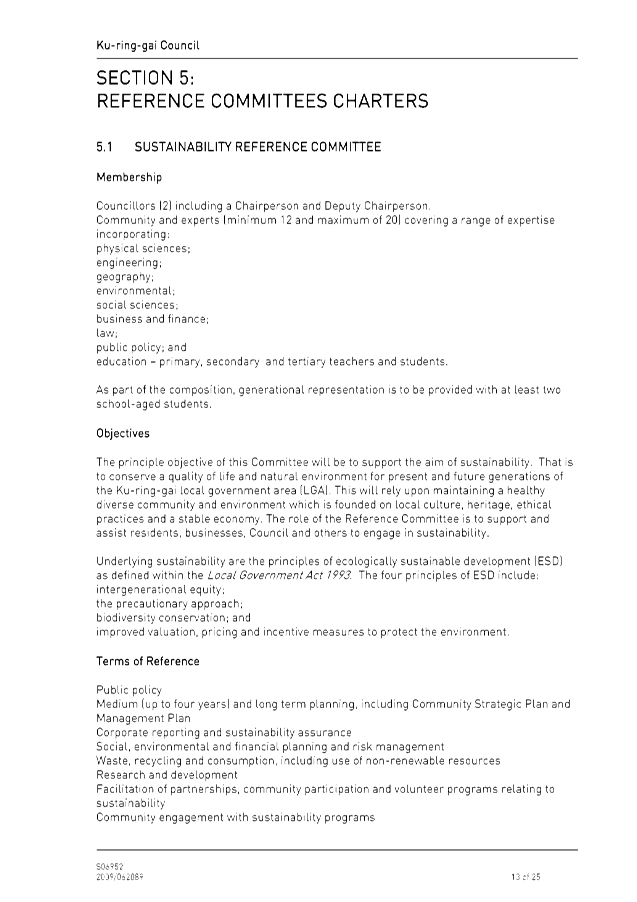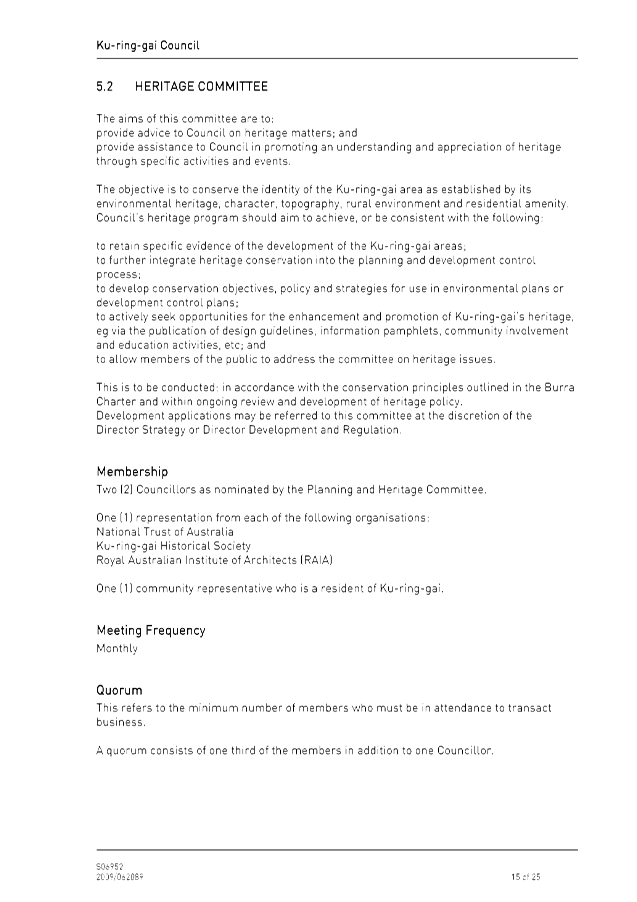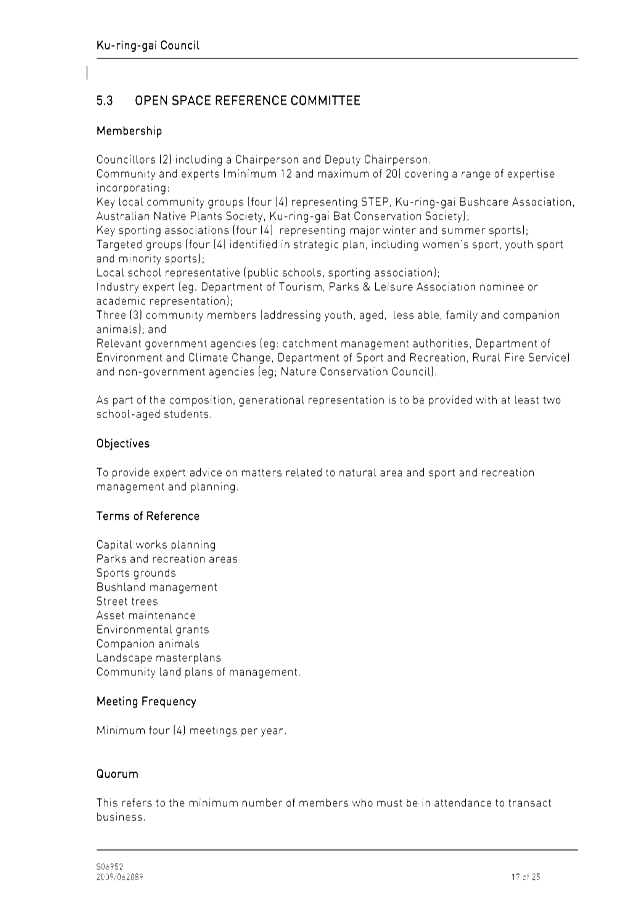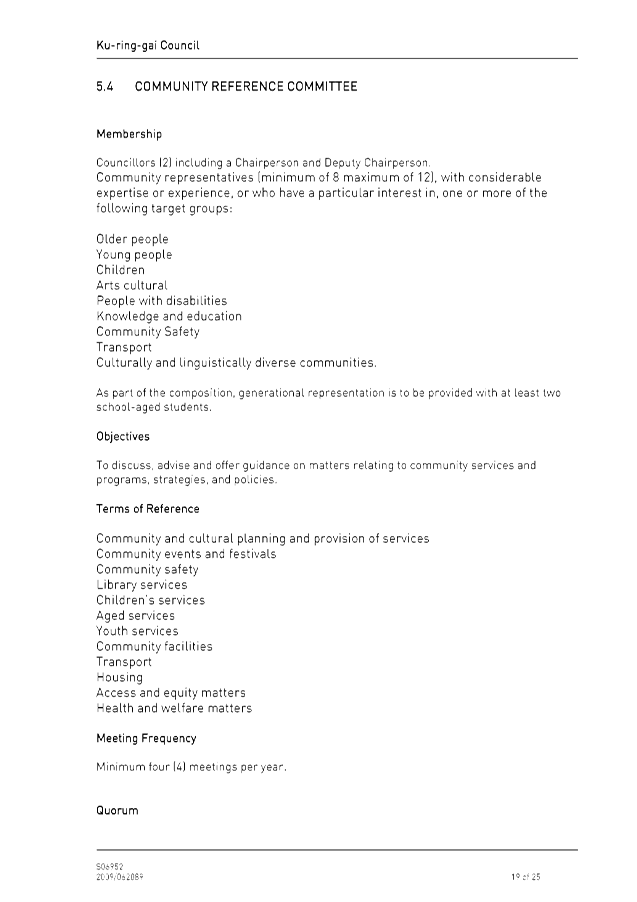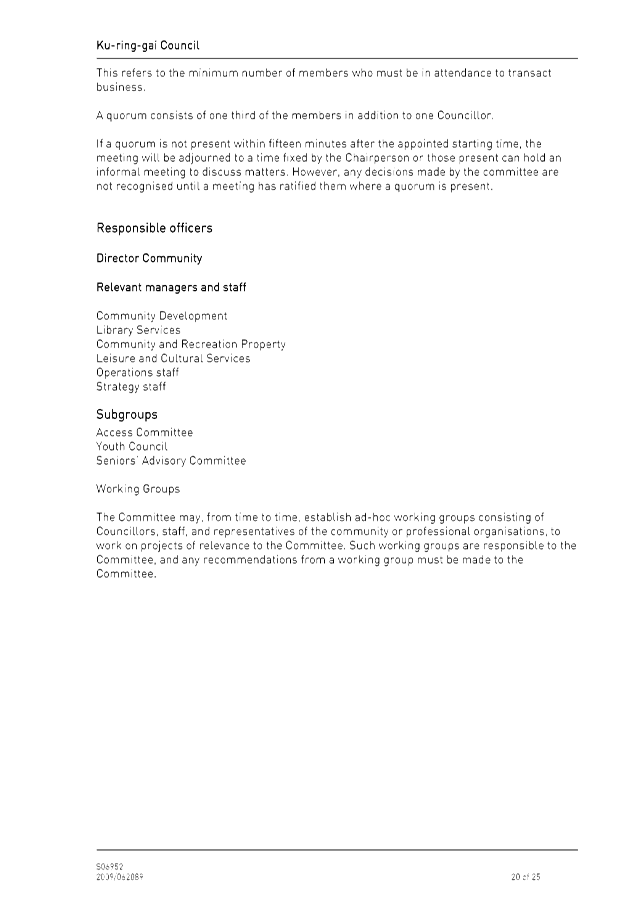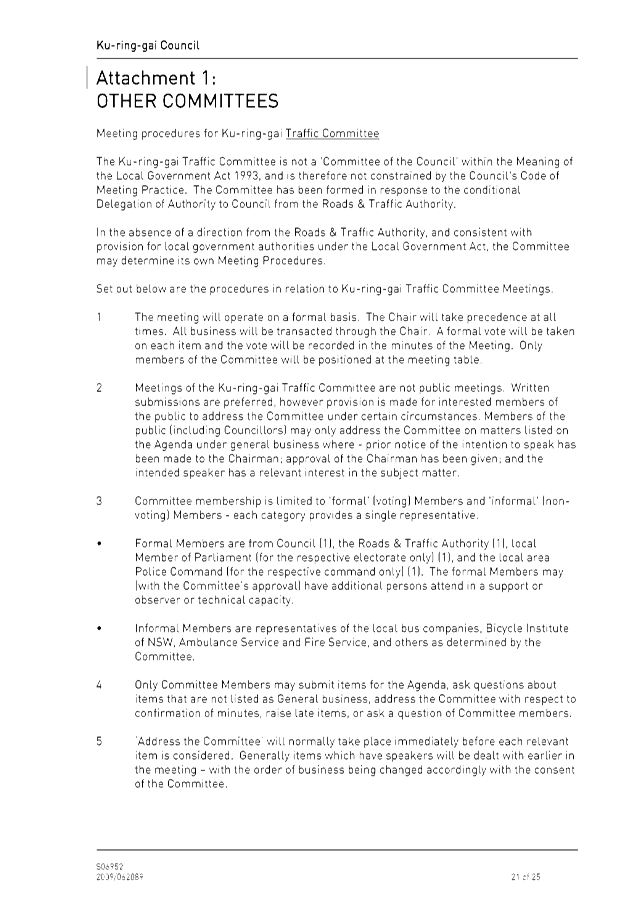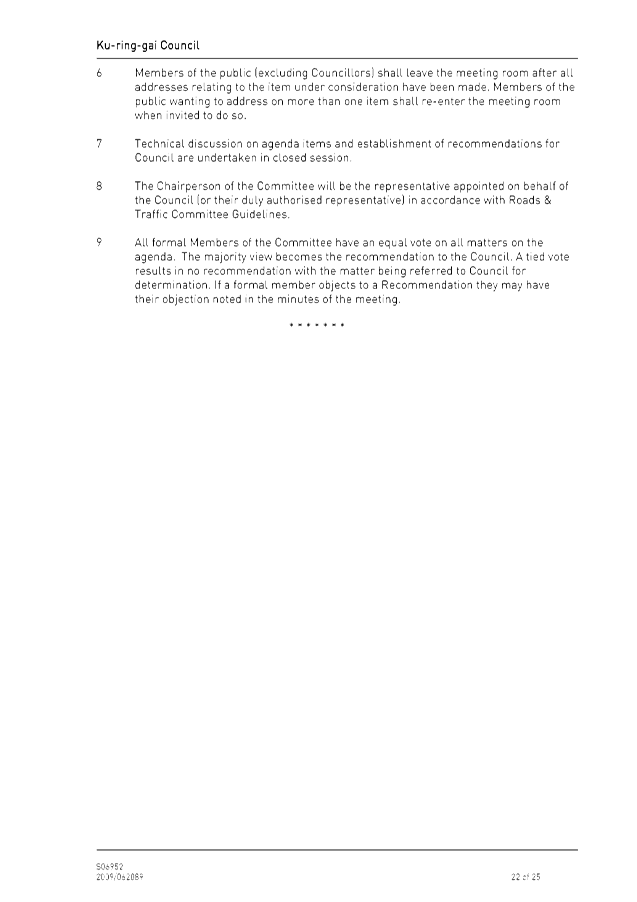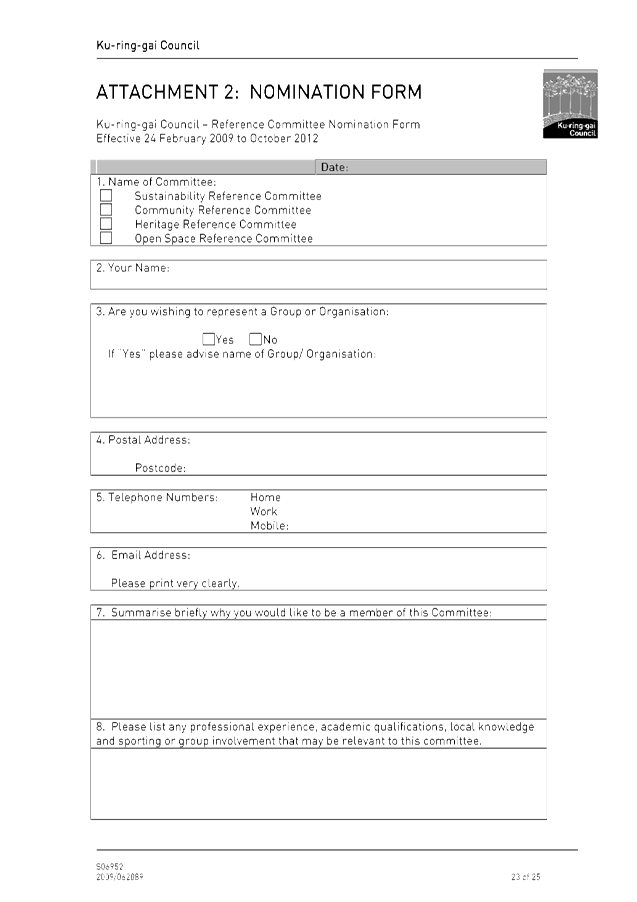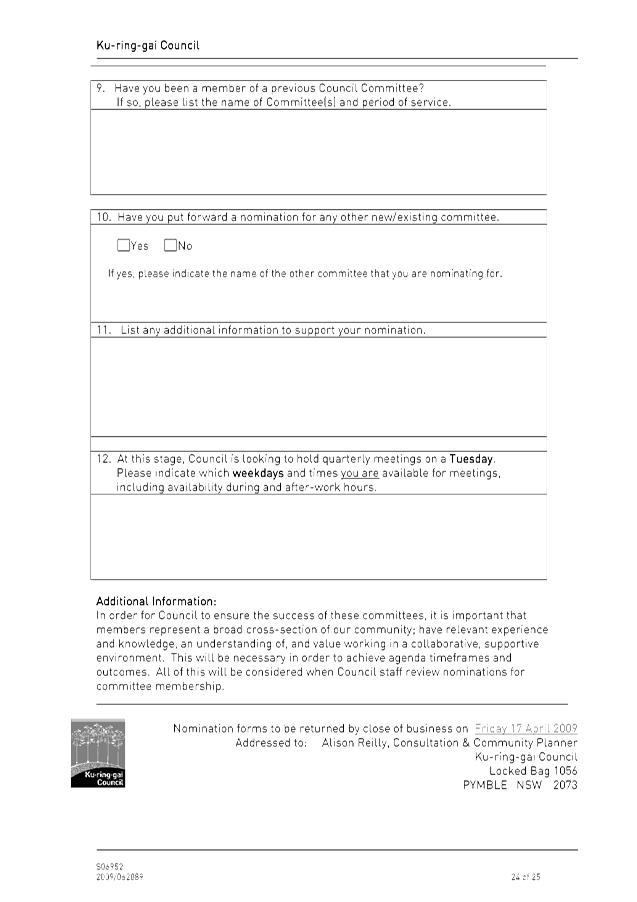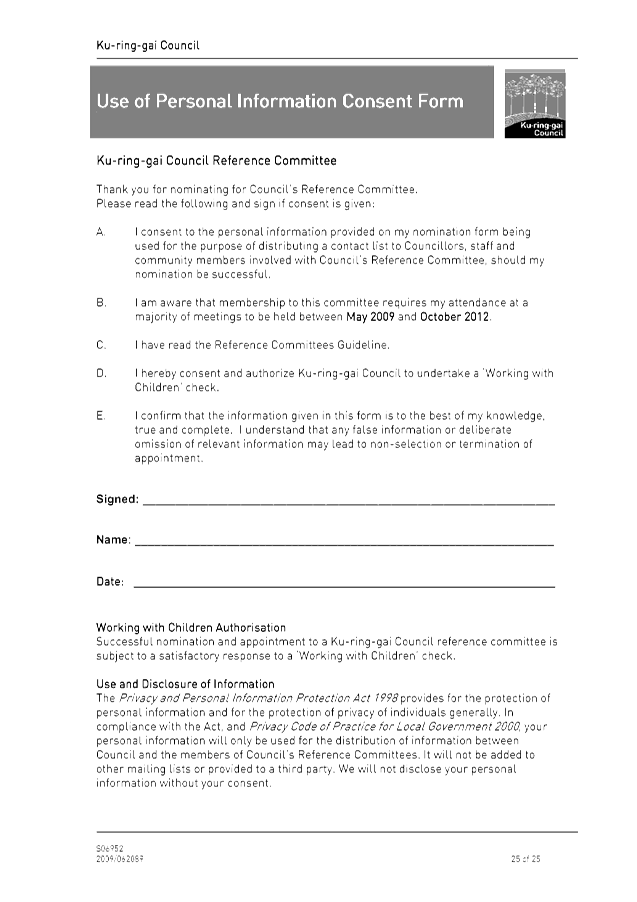|
Recommendation:
A. THAT
Council, as the consent authority, is of the opinion that the request
submitted under clause 4.6 of KLEP (Local Centres) 2012 to vary the site area
development standard has met the requirements of clause 4.6(4). Council is
also of the opinion that strict compliance with the development standard is
unreasonable and unnecessary in the circumstances of the case and that there
are sufficient environmental planning grounds to justify the variation to the
development standard.
AND
B. THAT
Council, as the consent authority, being satisfied that the proposed
development will be in the public interest, grant Deferred Commencement
Development Consent to DA0601/15 for the demolition of existing structures
and construction of 4 town houses with basement parking on land at 146 Mona
Vale Road, Pymble, subject to the following terms of Schedule A and
conditions of Schedule B below. Pursuant to the Environmental Planning and
Assessment Act, 1979. This consent lapses if the approved works are not
physically commenced within two years from the date on which the consent
becomes operable.
The
conditions of consent are as follows:
SCHEDULE
A: Deferred Commencement term to be satisfied prior to the consent
becoming operable
The following
Deferred Commencement term must be complied with to the satisfaction of
Council within 24 months of the date of issue of this Deferred Commencement
consent:
1. Drainage
easement (deferred commencement)
The applicant shall submit
documentary evidence that the property benefits from a registered drainage
easement or easements over all downstream properties as far as the public
drainage system. This consent will not operate until the documentary evidence
has been submitted to and approved by Council’s Development
Engineer. This documentation must include evidence that the easement
has been registered with NSW Land and Property Information.
Reason: To
ensure that provision is made for stormwater drainage from the site in a
proper manner that protects adjoining properties.
Once the consent becomes
operable, the conditions in Schedule B will apply. Upon written receipt from
Council that the Deferred Commencement condition in Schedule A has been
satisfied, the following conditions will apply:
SCHEDULE B - Conditions of
consent:
Conditions that identify approved plans:
1. Approved
architectural plans and documentation (new development)
The development must be
carried out in accordance with the following plans and documentation listed
below and endorsed with Council’s stamp, except where amended by other
conditions of this consent:
|
Plan no.
|
Drawn by
|
Dated
|
|
DA01 - DA10 (Rev. 5)
|
McCullum Ashby Architects
|
20/09/2016
|
|
Engineering
plans:
Drawings
C1 to C4 Issue C
|
ACOR
Consultants
|
19/09/2016
|
|
Landscape plan:
L01 15-834 Rev. A/3
|
Site Design Studios
|
15/09/2016
|
|
Document(s)
|
Dated
|
|
Basix certificate No.
690347M_03
|
1 November 2016
|
|
Geotechnical Investigation
Report (Geo-environmental Engineering)
|
1 February 2016
|
Reason: To
ensure that the development is in accordance with the determination.
2. Inconsistency
between documents
In the event of any
inconsistency between conditions of this consent and the drawings/documents
referred to above, the conditions of this consent prevail.
Reason: To
ensure that the development is in accordance with the determination.
3. Approved
landscape plans
Landscape works shall be
carried out in accordance with the following landscape plan(s), listed below
and endorsed with Council’s stamp, except where amended by other
conditions of this consent:
|
Plan no.
|
Drawn by
|
Dated
|
|
L01 15-834 Rev A/3
|
Site Design Studios
|
15/09/2016
|
Reason: To
ensure that the development is in accordance with the determination.
Conditions
to be satisfied prior to demolition, excavation or construction:
4. Asbestos
works
All
work involving asbestos products and materials, including
asbestos-cement-sheeting (ie. Fibro), must be carried out in accordance with
the guidelines for asbestos work published by WorkCover Authority of NSW.
Reason: To
ensure public safety.
5. Notice
of commencement
At least 48 hours prior to the
commencement of any development (including demolition, excavation, shoring or
underpinning works), a notice of commencement of building or subdivision work
form and appointment of the principal certifying authority form shall be
submitted to Council.
Reason: Statutory
requirement.
6. Notification
of builder’s details
Prior to the commencement of any development or
excavation works, the Principal Certifying Authority shall be notified in
writing of the name and contractor licence number of the owner/builder
intending to carry out the approved works.
Reason: Statutory
requirement.
7. Archival
recording of buildings
Prior to the
commencement of any development or excavation works on site, the Principal
Certifying Authority shall be satisfied that an archival report has been
submitted to Council’s Heritage Advisor.
The report must consist of an
archival standard photographic record of the building (internally and
externally), its garden and views of it from the street illustrating its
relationship to neighbouring properties and the streetscape. Recording shall
be undertaken in accordance with the guidelines for “Photographic
Recording of Heritage Items Using Film or Digital Capture (2006)”
prepared by the New South Wales Heritage Office.
Information
shall be bound in an A4 report format. It shall include copies of
photographs, referenced to plans of the site. Two (2) copies (one (1)
copy to include negatives or CD of images shall be submitted to Council's
Heritage Advisor. The recording document will be held in the local
studies collection of Ku-ring-gai Library, the local historical society and
Council’s files.
Note: A written acknowledgment
from Council must be obtained (attesting to this condition being
appropriately satisfied) and submitted to the Principal Certifying Authority
prior to the commencement of any works.
Reason: To
ensure the proper management of historical artefacts and to ensure their
preservation.
8. Dilapidation
photos (public infrastructure)
Prior to the commencement of
any works on site the applicant must submit to Ku-ring-gai Council and the
Principal Certifying Authority a photographic record on the visible condition
of the existing public infrastructure over the full site frontage (in
colour - preferably saved to cd-rom in ‘jpg’ format). The photos
must include detail of:
· The
existing footpath
· The
existing kerb and gutter
· The
existing full road surface between kerbs
· The
existing verge area
· The
existing driveway and layback where to be retained
· Any
existing drainage infrastructure including pits, lintels, grates.
Particular
attention must be paid to accurately recording any pre-developed damaged
areas on the aforementioned infrastructure so that Council is fully informed
when assessing damage to public infrastructure caused as a result of the
development (which is not to be repaired by the Applicant as part of the
development). The developer may be held liable to all damage to public
infrastructure in the vicinity of the site, where such damage is not
accurately recorded and demonstrated under the requirements of this condition
prior to the commencement of any works.
Reason: To
protect public infrastructure.
9. Dilapidation
survey and report (private property)
Prior to the commencement
of any demolition or excavation works on site, the Principal Certifying
Authority shall be satisfied that a dilapidation report on the visible and
structural condition of all structures upon the following lands, has been
completed and submitted to Council:
|
Address:
|
|
· 144
Mona Vale Road / 39B Pentecost Avenue
· 148-152
Mona Vale Road (southern-most building)
|
The
dilapidation report must include a photographic survey of adjoining
properties detailing their physical condition, both internally and
externally, including such items as walls ceilings, roof and structural
members. The report must be completed by a consulting structural/geotechnical
engineer as determined necessary by that professional based on the
excavations for the proposal and the recommendations of the submitted
geotechnical report.
In the event that access for
undertaking the dilapidation survey is denied by a property owner, the
applicant must demonstrate in writing to the satisfaction of the Principal
Certifying Authority that all reasonable steps have been taken to obtain
access and advise the affected property owner of the reason for the survey
and that these steps have failed.
Note: A
copy of the dilapidation report is to be provided to Council prior to any
excavation works been undertaken. The dilapidation report is for record
keeping purposes only and may be used by an applicant or affected property
owner to assist in any civil action required to resolve any dispute over
damage to adjoining properties arising from works.
Reason: To
record the structural condition of likely affected properties before works
commence.
10. Construction
and traffic management plan
The applicant must submit to
Council a Construction Traffic Management Plan (CTMP), which is to be
approved by Council and Roads and Maritime Services prior to the commencement
of any works on site.
The plan is to consist of a
report with Traffic Control Plans attached.
The report is to contain
commitments which must be followed by the demolition and excavation contractor,
builder, owner and subcontractors. The CTMP applies to all persons
associated with demolition, excavation and construction of the development.
The report is to contain
construction vehicle routes for approach and departure to and from all directions.
The report is to contain a
site plan showing entry and exit points. Swept paths are to be shown on
the site plan showing access and egress for an 11 metre long heavy rigid
vehicle.
The Traffic Control Plans are
to be prepared by a qualified person (red card holder). One must be
provided for each of the following stages of the works:
(i) Demolition
(ii) Excavation
(iii) Concrete pour
(iv) Construction of vehicular crossing and reinstatement of footpath
Traffic controllers must be in
place at the site entry and exit points to control heavy vehicle movements in
order to maintain the safety of pedestrians and other road users.
When a satisfactory CTMP is
received, a letter of approval will be issued with conditions attached.
Traffic management at the site must comply with the approved CTMP as well as
any conditions in the letter issued by Council. Council’s Rangers
will be patrolling the site regularly and fines may be issued for any non-compliance
with this condition.
Reason: To
ensure that appropriate measures have been considered during all phases of
the construction process in a manner that maintains the environmental amenity
and ensures the ongoing safety and protection of people.
11. Erosion
and drainage management
Earthworks
and/or demolition of any existing buildings shall not commence until an
erosion and sediment control plan is submitted to and approved by the
Principal Certifying Authority. The plan shall comply with the
guidelines set out in the NSW Department of Housing manual "Managing
Urban Stormwater: Soils and Construction". Erosion and sediment control
works shall be implemented in accordance with the erosion and sediment
control plan.
Reason: To
preserve and enhance the natural environment.
12. Tree
protection fencing
To preserve the following
tree/s, no work shall commence until the area beneath their canopy is fenced
off at the specified radius from the trunk/s to prevent any activities,
storage or the disposal of materials within the fenced area. The
fence/s shall be maintained intact until the completion of all
demolition/building work on site.
|
Tree/Location
|
Radius from trunk
|
|
T3 Photinia x fraseri
Robusta (Photinia)
North-east site corner
|
2.3m
|
|
T4 Photinia x fraseri
Robusta (Photinia)
North-east site corner
|
2.3m
|
|
T5 Photinia x fraseri
Robusta (Photinia)
North-east site corner
|
2.3m
|
|
T9 Camellia japonica
(Japanese Camellia)
Rear garden
|
2.5m
|
|
T10 Cedrus deodar
(Himalayan Cedar)
North-west site corner in
neighbouring site
|
6.0m east, 10.8m elsewhere
|
|
T11 Celtis sinensis
(Chinese Hackberry)
Southern site boundary in
neighbouring site
|
3.0m north, 9.6m elsewhere
|
|
T12 Celtis sinensis
(Chinese Hackberry)
Southern site boundary in
neighbouring site
|
3.0m north, 10.8m elsewhere
|
|
T13 Franklinia axillaris
(Gordonia)
South-east site corner
|
2.0m north, 4.5m elsewhere
|
Reason: To
protect existing trees during the construction phase.
13. Tree
protective fencing type galvanised mesh
The
tree protection fencing shall be constructed of galvanised pipe at 2.4 metres
spacing and connected by securely attached chain mesh fencing to a minimum
height of 1.8 metres in height prior to work commencing.
Reason: To protect existing trees during construction phase.
14. Tree
protection signage
Prior to works commencing, tree protection signage is to
be attached to each tree protection zone, displayed in a prominent position
and the sign repeated at 10 metres intervals or closer where the fence
changes direction. Each sign shall contain in a clearly legible form,
the following information:
Tree protection zone.
· This fence has been installed to prevent
damage to the trees and their growing environment both above and below ground
and access is restricted.
· Any encroachment not previously approved
within the tree protection zone shall be the subject of an arborist's report.
· The arborist's report shall provide proof that
no other alternative is available.
· The Arborist's report shall be submitted to
the Principal Certifying Authority for further consultation with Council.
· The name, address, and telephone number of the
developer.
Reason: To
protect existing trees during the construction phase.
15. Tree protection mulching
Prior to works commencing and throughout construction,
the area of the tree protection zone is to be mulched to a depth of 100mm
with composted organic material being 75% Eucalyptus leaf litter and 25%
wood.
Reason: To
protect existing trees during the construction phase.
16. Tree
fencing inspection
Upon
installation of the required tree protection measures, an inspection of the
site by the Principal Certifying Authority is required to verify that tree
protection measures comply with all relevant conditions.
Reason: To
protect existing trees during the construction phase.
17. Construction
waste management plan
Prior to the
commencement of any works, the Principal Certifying Authority shall be
satisfied that a waste management plan, prepared by a suitably qualified
person, has been prepared in accordance with Council’s Waste Management
controls in the Ku-ring-gai Development Control Plan.
The plan
shall address all issues identified in the DCP, including but not limited to:
the estimated volume of waste and method for disposal for the construction
and operation phases of the development.
Note: The
plan shall be provided to the Certifying Authority.
Reason: To
ensure appropriate management of construction waste.
18. Noise and
vibration management plan
Prior to the commencement of
any works, a noise and vibration management plan is to be prepared by a
suitably qualified expert addressing the likely noise and vibration from
demolition, excavation and construction of the proposed development and
provided to the Principal Certifying Authority.
The management plan is to identify amelioration measures to achieve the best
practice objectives of AS 2436-2010 and NSW Department of Environment and
Climate Change Interim Construction Noise Guidelines. The report shall be
prepared in consultation with any geotechnical report that itemises equipment
to be used for excavation works.
The management plan shall
address, but not be limited to, the following matters:
· identification
of the specific activities that will be carried out and associated noise
sources
· identification
of all potentially affected sensitive receivers, including residences,
churches, commercial premises, schools and properties containing noise
sensitive equipment
· the
construction noise objective specified in the conditions of this consent
· the
construction vibration criteria specified in the conditions of this consent
· determination
of appropriate noise and vibration objectives for each identified sensitive
receiver
· noise
and vibration monitoring, reporting and response procedures
· assessment
of potential noise and vibration from the proposed demolition, excavation and
construction activities, including noise from construction vehicles and any
traffic diversions
· description
of specific mitigation treatments, management methods and procedures that
will be implemented to control noise and vibration during construction
· construction
timetabling to minimise noise impacts including time and duration
restrictions, respite periods and frequency
· procedures
for notifying residents of construction activities that are likely to affect
their amenity through noise and vibration
· contingency
plans to be implemented in the event of non-compliances and/or noise
complaints
Reason: To
protect the amenity afforded to surrounding residents during the construction
process.
Conditions
to be satisfied prior to the issue of the construction certificate:
19. Amendments
to approved landscape plan
Prior to the issue of a
Construction Certificate, the Principal Certifying Authority shall be
satisfied that the approved landscape plans, listed below and endorsed with
Council’s stamp, have been amended in accordance with the requirements
of this condition as well as other conditions of this consent:
|
Plan no.
|
Drawn by
|
Dated
|
|
L01 15-834 Rev A/3
|
Site Design Studios
|
15/09/2016
|
The above landscape plan shall
be amended as follows:
· The
proposed courtyard fences shall be deleted as perimeter soft landscape areas
are communally owned.
· T6
and T7 shall be shown to be removed and replaced with a tall tree species
capable of attaining a minimum height of 13.0m midway between the northern
site boundary and the proposed driveway.
· The
proposed concrete pad in front of the feature wall within the site frontage
shall be deleted and replaced with low plantings
Prior to the issue of the
Construction Certificate, the Principal Certifying Authority shall be
satisfied that the landscape plan has been amended are required by this
condition.
Note: An amended plan, prepared
by a landscape architect or qualified landscape designer shall be submitted
to the Certifying Authority.
Reason: To ensure adequate landscaping of the site.
20. Amendments
to approved engineering plans
Prior
to the issue of a Construction Certificate, the Certifying Authority shall be
satisfied that the approved engineering plan(s), listed below and endorsed
with Council’s stamp, have been amended in accordance with the
requirements of this condition as well as other conditions of this consent:
|
Plan
no.
|
Drawn
by
|
Dated
|
|
Drawings
C1 to C4 Issue C
|
ACOR
Consultants
|
19.09.16
|
The
above engineering plan(s) shall be amended as follows:
1
Measures are to be provided to achieve Council's water quality targets (refer
Part 24C.6 of Ku-ring-gai DCP). These may include pit inserts or
proprietary products provided there is no effect on the deep soil or
landscaping.
2. Re-use
of retained roofwater is to be for toilet flushing, clothes washing and
irrigation. This is to be clearly stated on the plans.
Note: An amended engineering plan, prepared
by a qualified engineer shall be submitted to the Certifying Authority.
Reason: To
ensure that the development is in accordance with the determination.
21. Long
service levy
In accordance with Section
109F(i) of the Environmental Planning and Assessment Act a Construction
Certificate shall not be issued until any long service levy payable under
Section 34 of the Building and Construction Industry Long Service Payments
Act 1986 (or where such levy is payable by instalments, the first instalment
of the levy) has been paid. Council is authorised to accept payment. Where
payment has been made elsewhere, proof of payment is to be provided to
Council.
Reason: Statutory
requirement.
22. Builder’s
indemnity insurance
The
applicant, builder, developer or person who does the work on this
development, must arrange builder’s indemnity insurance and submit the certificate
of insurance in accordance with the requirements of Part 6 of the Home
Building Act 1989 to the Certifying Authority for endorsement of the plans
accompanying the Construction Certificate.
It is the
responsibility of the applicant, builder or developer to arrange the
builder's indemnity insurance for residential building work over the value of
$20,000. The builder's indemnity insurance does not apply to commercial or
industrial building work or to residential work valued at less than $20,000,
nor to work undertaken by persons holding an owner/builder's permit issued by
the Department of Fair Trading (unless the owner/builder's property is sold
within 7 years of the commencement of the work).
Reason: Statutory
requirement.
23. Outdoor
lighting
Prior to the issue of a
Construction Certificate, the Certifying Authority shall be satisfied that
all outdoor lighting will comply with AS/NZ1158.3: 1999 Pedestrian Area
(Category P) Lighting and AS4282: 1997 Control of the Obtrusive Effects of
Outdoor Lighting.
Note: Details
demonstrating compliance with these requirements are to be submitted prior to
the issue of a Construction Certificate.
Reason: To
provide high quality external lighting for security without adverse affects
on public amenity from excessive illumination levels.
24. Air drying
facilities
Prior to the issue of the
Construction Certificate, the Certifying Authority shall be satisfied that a
common open space area dedicated for open air drying of clothes is provided.
This area is to be located at ground level behind the building line and in a
position not visible from the public domain.
In
lieu of the above, written confirmation that all units will be provided with
internal clothes drying facilities prior to the Occupation Certificate is to
be submitted to the Certifying Authority prior to the issue of the
Construction Certificate.
Reason: Amenity & energy efficiency.
25. External
service pipes and the like prohibited
Proposed water pipes, waste
pipes, stack work, duct work, mechanical ventilation plant and the like must
be located within the building. Details confirming compliance with this
condition must be shown on construction certificate plans and detailed with
construction certificate specifications. Required external vents or
vent pipes on the roof or above the eaves must be shown on construction
certificate plans and detailed with construction certificate
specifications. External vents or roof vent pipes must not be visible
from any place unless detailed upon development consent plans. Where
there is any proposal to fit external service pipes or the like this must be
detailed in an amended development (S96) application and submitted to Council
for determination.
Vent pipes required by Sydney
Water must not be placed on the front elevation of the building or front roof
elevation. The applicant, owner and builder must protect the appearance
of the building from the public place and the appearance of the streetscape
by elimination of all external services excluding vent pipes required by
Sydney Water and those detailed upon development consent plans.
Reason: To protect the streetscape and the integrity
of the approved development.
26. Access for
people with disabilities (residential)
Prior to the issue of the
Construction Certificate, the Certifying Authority shall be satisfied that
access for people with disabilities to and from and between the public
domain, residential units and all common open space areas is provided.
Consideration must be given to the means of dignified and equitable access.
Compliant access provisions
for people with disabilities shall be clearly shown on the plans
submitted with the Construction Certificate. All details shall be
provided to the Principal Certifying Authority prior to the issue of the
Construction Certificate. All details shall be prepared in consideration of
the Disability Discrimination Act, and the relevant provisions of AS1428.1,
AS1428.2, AS1428.4 and AS 1735.12.
Reason: To
ensure the provision of equitable and dignified access for all people in
accordance with disability discrimination legislation and relevant Australian
Standards.
27. Adaptable
units
Prior to the issue of the Construction Certificate, the Certifying
Authority shall be satisfied that one of the units within the development
application is designed as adaptable housing in accordance with the
provisions of Australian Standard AS4299-1995: Adaptable Housing.
Note: Evidence from an
appropriately qualified professional demonstrating compliance with this
control is to be submitted to and approved by the Certifying Authority prior
to the issue of the Construction Certificate.
Reason: Disabled
access & amenity.
28. Excavation
for services
Prior
to the issue of the Construction Certificate, the Principal Certifying Authority
shall be satisfied that no proposed underground services (ie: water,
sewerage, drainage, gas or other service) unless previously approved by
conditions of consent, are located beneath the canopy of any tree protected
under Council’s Tree Preservation Order, located on the subject
allotment and adjoining allotments.
Note: A plan detailing the routes of these
services and trees protected under the Tree Preservation Order shall be
submitted to the Principal Certifying Authority.
Reason: To
ensure the protection of trees.
29. Recycling
and waste management
Prior to the
issue of the Construction Certificate, the Certifying Authority shall be
satisfied that the development provides a common garbage
collection/separation area sufficient in size to store all wheelie garbage
bins and recycling bins provided by Council for the number of units in the
development in accordance with Council’s DCP. The garbage collection
point is to be accessible by Council’s Waste Collection Services.
The
responsibility for:
· the cleaning of waste rooms and waste service compartments; and
· the transfer of bins within the property, and to the collection
point once the development is in use;
shall be
determined when designing the system and clearly stated in the Waste
Management Plan.
Note: The
architectural plans are to be amended where required and provided to the
Certifying Authority.
Reason: Environmental
protection.
30. Noise from
road and rail (residential only)
Prior to the issue of the
Construction Certificate, the Certifying Authority shall submit evidence to
Council demonstrating that the development will be acoustically designed and
constructed to ensure that the following LAeq levels are not exceeded:
(a) in any bedroom in the
building—35 dB(A) at any time between 10 pm and 7 am,
(b) anywhere else in the
building (other than a garage, kitchen, bathroom or hallway)—40 dB(A)
at any time.
Plans and specifications of
the required acoustic design shall be prepared by a practicing acoustic
engineer and shall be submitted to the Principal Certifying Authority.
Reason: To
minimise the impact of noise from the adjoining road or rail corridor on the
occupants of the development.
31. Noise from
plant in residential zone
Where any form of mechanical
ventilation equipment or other noise generating plant is proposed as part of
the development, prior to the issue of the Construction Certificate the
Certifying Authority, shall be satisfied that the operation of an individual
piece of equipment or operation of equipment in combination will not exceed
more than 5dB(A) above the background level during the day when measured at
the site’s boundaries and shall not exceed the background level at night
(10.00pm –6.00 am) when measured at the boundary of the site.
C1. Note: A certificate from an
appropriately qualified acoustic engineer is to be submitted with the
Construction Certificate, certifying that all mechanical ventilation
equipment or other noise generating plant in isolation or in combination with
other plant will comply with the above requirements.
Reason: To
comply with best practice standards for residential acoustic amenity.
32. Location of
plant
Prior to the issue of the
Construction Certificate, the Certifying Authority shall be satisfied that
all plant and equipment (including but not limited to air conditioning
equipment) is located within the basement.
C1. Note: Architectural plans
identifying the location of all plant and equipment shall be provided to the
Certifying Authority.
Reason: To
minimise impact on surrounding properties, improved visual appearance and
amenity for locality.
33. Driveway
crossing levels
Prior to issue of the Construction
Certificate, driveway and associated footpath levels for any new,
reconstructed or extended sections of driveway crossings between the property
boundary and road alignment must be obtained from Ku-ring-gai Council. Such
levels are only able to be issued by Council under the Roads Act 1993.
Please note Roads and
Maritime Services are to approve the gutter crossing as required under a
separate condition of this consent.
Specifications are issued with
alignment levels after completing the necessary application form at Customer
Services and payment of the assessment fee. When completing the request for
driveway levels application from Council, the applicant must attach a copy of
the relevant development application drawing which indicates the position and
proposed level of the proposed driveway at the boundary alignment.
This development consent is
for works wholly within the property. Development consent does not imply approval
of footpath or driveway levels, materials or location within the road
reserve, regardless of whether this information is shown on the development
application plans. The grading of such footpaths or driveways outside the
property shall comply with Council's standard requirements. The
suitability of the grade of such paths or driveways inside the property is
the sole responsibility of the applicant and the required alignment levels
fixed by Council may impact upon these levels.
The construction of footpaths
and driveways outside the property in materials other than those approved by
Council is not permitted.
Reason: To
provide suitable vehicular access without disruption to pedestrian and
vehicular traffic.
34. Driveway
grades - basement carparks
Prior to the issue of the
Construction Certificate, longitudinal driveway sections are to be prepared
by a qualified civil/traffic engineer and be submitted for to and approved by
the Certifying Authority. These profiles are to be at 1:100 scale along both
edges of the proposed driveway, starting from the centreline of the frontage
street carriageway to the proposed basement floor level. The traffic engineer
shall provide specific written certification on the plans that:
· vehicular
access can be obtained using grades of 20% (1 in 5) maximum and
· all
changes in grade (transitions) comply with Australian Standard 2890.1
-“Off-street car parking” (refer clause 2.5.3) to prevent the
scraping of the underside of vehicles.
If a new driveway crossing is
proposed, the longitudinal sections must incorporate the driveway crossing
levels as issued by Council upon prior application.
Reason: To
provide suitable vehicular access without disruption to pedestrian and
vehicular traffic.
35. Basement
car parking details
Prior to issue of the
Construction Certificate, certified parking layout plan(s) to scale showing
all aspects of the vehicle access and accommodation arrangements must be
submitted to and approved by the Certifying Authority. A qualified civil/traffic
engineer must review the proposed vehicle access and accommodation layout and
provide written certification on the plans that:
· all
parking space dimensions, driveway and aisle widths, driveway grades,
transitions, circulation ramps, blind aisle situations and other trafficked
areas comply with Australian Standard 2890.1 - 2004 “Off-street car
parking”
· a
clear height clearance of 2.6 metres is provided over the designated
garbage collection truck manoeuvring areas within the basement
· no
doors or gates are provided in the access driveways to the basement carpark
which would prevent unrestricted access for internal garbage collection at
any time from the basement garbage storage and collection area
· the
vehicle access and accommodation arrangements are to be constructed and
marked in accordance with the certified plans
Reason: To
ensure that parking spaces are in accordance with the approved development.
36. Car parking
allocation
Car parking within the
development shall be allocated in the following way:
|
Resident car spaces
|
9 (max)
|
|
Visitor spaces
|
1 (min)
|
|
Total spaces
|
10
|
Each adaptable dwelling must
be provided with car parking complying with the dimensional and location
requirements of AS2890.1 - parking spaces for people with disabilities.
At least one visitor space
shall also comply with the dimensional and location requirements of AS2890.1
- parking spaces for people with disabilities.
Consideration must be given to
the means of access from disabled car parking spaces to other areas within
the building and to footpath and roads and shall be clearly shown on the
plans submitted with the Construction Certificate.
A tap is to be provided to a
visitor space to enable provision for on-site car washing.
Reason: To
ensure equity of access and appropriate facilities are available for people
with disabilities in accordance with federal legislation.
37. Bicycle
parking space
The basement car park shall
provide bicycle parking space in accordance with the Local Centres DCP and
designed in accordance with AS2890.3. Details shall be submitted to the
satisfaction of the Certifying Authority prior to the issue of a Construction
Certificate.
Reason: To
provide alternative modes of transport to and from the site.
38. Energy
Australia requirements
Prior to issue of the
Construction Certificate, the applicant must contact Energy Australia
regarding power supply for the subject development. A written response
detailing the full requirements of Energy Australia (including any need for
underground cabling, substations or similar within or in the vicinity the
development) shall be submitted to the Principal Certifying Authority for
approval prior to issue of the Construction Certificate.
Any structures or other
requirements of Energy Australia shall be indicated on the plans issued with
the Construction Certificate, to the satisfaction of the Principal Certifying
Authority and Energy Australia. The requirements of Energy Australia must be
met in full prior to issue of the Occupation Certificate.
Reason: To
ensure compliance with the requirements of Energy Australia.
39. Utility
provider requirements
Prior to issue of the
Construction Certificate, the applicant must make contact with all relevant
utility providers whose services will be impacted upon by the development. A
written copy of the requirements of each provider, as determined necessary by
the Certifying Authority, must be obtained. All utility services or
appropriate conduits for the same must be provided by the developer in accordance
with the specifications of the utility providers.
Reason: To
ensure compliance with the requirements of relevant utility providers.
40. Underground
services
All electrical services
(existing and proposed) shall be undergrounded from the proposed building on
the site to the appropriate power pole(s) or other connection point.
Undergrounding of services must not disturb the root system of existing trees
and shall be undertaken in accordance with the requirements of the relevant
service provided. Documentary evidence that the relevant service provider has
been consulted and that their requirements have been met are to be provided
to the Certifying Authority prior to the issue of the Construction
Certificate. All electrical and telephone services to the subject property
must be placed underground and any redundant poles are to be removed at the
expense of the applicant.
Reason: To
provide infrastructure that facilitates the future improvement of the
streetscape by relocation of overhead lines below ground.
Conditions
to be satisfied prior to the issue of the construction certificate or prior to demolition, excavation
or construction (whichever comes first):
41. Infrastructure
damage security bond and inspection fee
To ensure that any damage to
Council property as a result of construction activity is rectified in a
timely matter:
(a) All work or activity undertaken pursuant to
this development consent must be undertaken in a manner to avoid damage to
Council property and must not jeopardise the safety of any person using or
occupying the adjacent public areas.
(b) The applicant, builder, developer or any
person acting in reliance on this consent shall be responsible for making
good any damage to Council property and for the removal from Council property
of any waste bin, building materials, sediment, silt, or any other material
or article.
(c) The Infrastructure damage security bond and
infrastructure inspection fee must be paid to Council by the applicant prior
to both the issue of the Construction Certificate and the commencement of any
earthworks or construction.
(d) In consideration of payment of the
infrastructure damage security bond and infrastructure inspection fee,
Council will undertake such inspections of Council Property as Council
considers necessary and will also undertake, on behalf of the applicant, such
restoration work to Council property, if any, that Council considers
necessary as a consequence of the development. The provision of such
restoration work by the Council does not absolve any person of the
responsibilities contained in (a) to (b) above. Restoration work to be
undertaken by Council referred to in this condition is limited to work that
can be undertaken by Council at a cost of not more than the Infrastructure
damage security bond payable pursuant to this condition.
(e) In this condition:
“Council
property” includes any road, footway, footpath paving, kerbing,
guttering, crossings, street furniture, seats, letter bins, trees, shrubs,
lawns, mounds, bushland, and similar structures or features on any road or
public road within the meaning of the Local Government Act 1993 (NSW) or any
public place; and
“Infrastructure
damage security bond and infrastructure inspection fee” means the
Infrastructure damage security bond and infrastructure inspection fee as
calculated in accordance with the Schedule of Fees & Charges adopted by
Council as at the date of payment and the cost of any inspections required by
the Council of Council property associated with this condition.
Reason: To maintain
public infrastructure.
42. Section
94 Contributions - Centres
This
development is subject to a development contribution calculated in accordance
with Ku-ring-gai Contributions Plan 2010, being a s94 Contributions Plan in
effect under the Environmental Planning and Assessment Act, as follows:
|
Infrastructure
Type
|
Total
|
|
LGA Wide
Local Recreational & Cultural
|
$6,741.83
|
|
St Ives
TC Local Parks & Sporting Facilities
|
$60,134.49
|
|
St Ives
TC New Roads & Road Mods
|
$2,861.20
|
|
St Ives
TC Townscape Transport & Pedest Fac
|
$31,563.87
|
|
Development Contributions
Total
|
$101,301.39
|
The
contribution shall be paid to Council prior to the issue of any Construction
Certificate, Linen Plan, Certificate of Subdivision or Occupation Certificate
whichever comes first in accordance with Ku-ring-gai Contributions
Plan 2010.
The
contributions specified above are subject to indexation and will continue to
be indexed to reflect changes in the consumer price index and housing price
index until they are paid in accordance with Ku-ring-gai Contributions Plan
2010 to reflect changes in the consumer price index and housing price
index. Prior to payment, please contact Council directly to verify the
current payable contributions.
Copies
of Council’s Contribution Plans can be viewed at Council Chambers, 818
Pacific Hwy Gordon or on Council’s website at www.kmc.nsw.gov.au.
Reason: To ensure the provision, extension or augmentation of the
Key Community Infrastructure identified in Ku-ring-gai Contributions Plan
2010 that will, or is likely to be, required as a consequence of the
development.
Conditions
to be satisfied during the demolition, excavation and construction phases:
43. Road opening permit
The opening of any footway, roadway, road
shoulder or any part of the road reserve shall not be carried out without a
road opening permit being obtained from Council (upon payment of the required
fee) beforehand.
Reason: Statutory requirement (Roads Act 1993 Section 138) and to maintain
the integrity of Council’s infrastructure.
44. Prescribed
conditions
The applicant shall comply
with any relevant prescribed conditions of development consent under clause
98 of the Environmental Planning and Assessment Regulation. For the purposes
of section 80A (11) of the Environmental Planning and Assessment Act, the
following conditions are prescribed in relation to a development consent for
development that involves any building work:
· The
work must be carried out in accordance with the requirements of the Building
Code of Australia
· In
the case of residential building work for which the Home Building Act 1989
requires there to be a contract of insurance in force in accordance with Part
6 of that Act, that such a contract of insurance is in force before any works
commence.
Reason: Statutory
requirement.
45. Hours of
work
Demolition, construction work
and deliveries of building material and equipment must not take place outside
the hours of 7.00am to 5.00pm Monday to Friday and 8.00am to 12 noon
Saturday. No work and no deliveries are to take place on Sundays and public
holidays.
Excavation using machinery
must be limited to between 7.00am and 5.00pm Monday to Friday, with a respite
break of 45 minutes between 12 noon and 1.00pm. No excavation using
machinery is to occur on Saturdays, Sundays or public holidays.
Where it is necessary for
works to occur outside of these hours (ie) placement of concrete for large
floor areas on large residential/commercial developments or where building
processes require the use of oversized trucks and/or cranes that are
restricted by the RTA from travelling during daylight hours to deliver, erect
or remove machinery, tower cranes, pre-cast panels, beams, tanks or service
equipment to or from the site, approval for such activities will be subject
to the issue of an "outside of hours works permit" from Council as
well as notification of the surrounding properties likely to be affected by
the proposed works.
Note: Failure
to obtain a permit to work outside of the approved hours will result in on
the spot fines being issued.
Reason: To ensure
reasonable standards of amenity for occupants of neighbouring properties.
46. Approved
plans to be on site
A
copy of all approved and certified plans, specifications and documents
incorporating conditions of consent and certification (including the
Construction Certificate if required for the work) shall be kept on site at
all times during the demolition, excavation and construction phases and must
be readily available to any officer of Council or the Principal Certifying
Authority.
Reason: To
ensure that the development is in accordance with the determination.
47. Statement
of compliance with Australian Standards
The demolition work shall
comply with the provisions of Australian Standard AS2601: 2001 The Demolition
of Structures. The work plans required by AS2601: 2001 shall be accompanied
by a written statement from a suitably qualified person that the proposal contained
in the work plan comply with the safety requirements of the Standard. The
work plan and the statement of compliance shall be submitted to the
satisfaction of the Principal Certifying Authority prior to the commencement
of any works.
Reason: To ensure
compliance with the Australian Standards.
48. Construction
noise
During excavation, demolition
and construction phases, noise generated from the site shall be controlled in
accordance with the recommendations of the approved noise and vibration management
plan.
Reason: To
ensure reasonable standards of amenity to neighbouring properties.
49. Site notice
A site notice shall be erected
on the site prior to any work commencing and shall be displayed throughout
the works period.
The site notice must:
· be
prominently displayed at the boundaries of the site for the purposes of
informing the public that unauthorised entry to the site is not permitted
· display
project details including, but not limited to the details of the builder,
Principal Certifying Authority and structural engineer
· be
durable and weatherproof
· display
the approved hours of work, the name of the site/project manager, the
responsible managing company (if any), its address and 24 hour contact phone
number for any inquiries, including construction/noise complaint are to be
displayed on the site notice
· be
mounted at eye level on the perimeter hoardings/fencing and is to state that
unauthorised entry to the site is not permitted
Reason: To
ensure public safety and public information.
50. Dust
control
During excavation, demolition
and construction, adequate measures shall be taken to prevent dust from
affecting the amenity of the neighbourhood. The following measures must be
adopted:
· physical
barriers shall be erected at right angles to the prevailing wind direction or
shall be placed around or over dust sources to prevent wind or activity from
generating dust
· earthworks
and scheduling activities shall be managed to coincide with the next stage of
development to minimise the amount of time the site is left cut or exposed
· all
materials shall be stored or stockpiled at the best locations
· the
ground surface should be dampened slightly to prevent dust from becoming
airborne but should not be wet to the extent that run-off occurs
· all
vehicles carrying spoil or rubble to or from the site shall at all times be
covered to prevent the escape of dust
· all
equipment wheels shall be washed before exiting the site using manual or
automated sprayers and drive-through washing bays
· gates
shall be closed between vehicle movements and shall be fitted with shade
cloth
· cleaning
of footpaths and roadways shall be carried out daily
Reason: To
protect the environment and amenity of surrounding properties.
51. Further
geotechnical input
The geotechnical and
hydro-geological works implementation, inspection, testing and monitoring
program for the excavation and construction works must be in accordance with
the report by Geo-environmental dated 1 February 2016. Over the course
of the works, a qualified geotechnical/hydro-geological engineer must
complete the following:
· further
geotechnical investigations and testing recommended in the above report(s)
and as determined necessary
· further
monitoring and inspection at the hold points recommended in the above
report(s) and as determined necessary
· written
report(s) including certification(s) of the geotechnical inspection, testing
and monitoring programs
Reason: To
ensure the safety and protection of property.
52. Compliance
with submitted geotechnical report
A contractor with specialist
excavation experience must undertake the excavations for the development and
a suitably qualified and consulting geotechnical engineer must oversee
excavation.
Geotechnical aspects of the
development work, namely:
· appropriate
excavation method and vibration control
· support
and retention of excavated faces
· hydro-geological
considerations
must be undertaken in
accordance with the recommendations of the geotechnical report prepared by Geo-environmental
dated 1 February 2016. Approval must be obtained from all affected
property owners, including Ku-ring-gai Council, where rock anchors (both
temporary and permanent) are proposed below adjoining property(ies).
Reason: To
ensure the safety and protection of property.
53. Use
of road or footpath
During
excavation, demolition and construction phases, no building materials, plant
or the like are to be stored on the road or footpath without written approval
being obtained from Council beforehand. The pathway shall be kept in a
clean, tidy and safe condition during building operations. Council
reserves the right, without notice, to rectify any such breach and to charge
the cost against the applicant/owner/builder, as the case may be.
Reason: To
ensure safety and amenity of the area.
54. Guarding
excavations
All
excavation, demolition and construction works shall be properly guarded and
protected with hoardings or fencing to prevent them from being dangerous to
life and property.
Reason: To
ensure public safety.
55. Toilet
facilities
During
excavation, demolition and construction phases, toilet facilities are to be
provided, on the work site, at the rate of one toilet for every 20 persons or
part of 20 persons employed at the site.
Reason: Statutory
requirement.
56. Protection
of public places
If the work
involved in the erection, demolition or construction of the development is
likely to cause pedestrian or vehicular traffic in a public place to be
obstructed or rendered inconvenient, or building involves the enclosure of a
public place, a hoarding or fence must be erected between the work site and
the public place.
If necessary,
a hoarding is to be erected, sufficient to prevent any substance from, or in
connection with, the work falling into the public place.
The work site
must be kept lit between sunset and sunrise if it is likely to be hazardous
to persons in the public place.
Any hoarding,
fence or awning is to be removed when the work has been completed.
Reason: To
protect public places.
57. Recycling
of building material (general)
During demolition and
construction, the Principal Certifying Authority shall be satisfied that
building materials suitable for recycling have been forwarded to an
appropriate registered business dealing in recycling of materials. Materials
to be recycled must be kept in good order.
Reason: To
facilitate recycling of materials.
58. Construction
signage
All construction signs must
comply with the following requirements:
· are
not to cover any mechanical ventilation inlet or outlet vent
· are
not illuminated, self-illuminated or flashing at any time
· are
located wholly within a property where construction is being undertaken
· refer
only to the business(es) undertaking the construction and/or the site at
which the construction is being undertaken
· are
restricted to one such sign per property
· do
not exceed 2.5m2
· are
removed within 14 days of the completion of all construction works
Reason: To
ensure compliance with Council's controls regarding signage.
59. Approval
for rock anchors
Approval
is to be obtained from the property owner for any anchors proposed beneath
adjoining private property. If such approval cannot be obtained, then
the excavated faces are to be shored or propped in accordance with the
recommendations of the geotechnical and structural engineers.
Reason: To
ensure the ongoing safety and protection of property.
60. Road
reserve safety
All public footways and
roadways fronting and adjacent to the site must be maintained in a safe
condition at all times during the course of the development works.
Construction materials must not be stored in the road reserve. A safe
pedestrian circulation route and a pavement/route free of trip hazards must
be maintained at all times on or adjacent to any public access ways fronting
the construction site. Where public infrastructure is damaged, repair
works must be carried out when and as directed by Council officers. Where
pedestrian circulation is diverted on to the roadway or verge areas, clear
directional signage and protective barricades must be installed in accordance
with AS1742-3 (1996) “Traffic Control Devices for Work on Roads”.
If pedestrian circulation is not satisfactorily maintained across the site
frontage, and action is not taken promptly to rectify the defects, Council
may undertake proceedings to stop work.
Reason: To
ensure safe public footways and roadways during construction.
61. Services
Where required, the adjustment
or inclusion of any new utility service facilities must be carried out by the
applicant and in accordance with the requirements of the relevant utility
authority. These works shall be at no cost to Council. It is the applicants’
full responsibility to make contact with the relevant utility authorities to
ascertain the impacts of the proposal upon utility services (including water,
phone, gas and the like). Council accepts no responsibility for any matter
arising from its approval to this application involving any influence upon
utility services provided by another authority.
Reason: Provision
of utility services.
62. Temporary
rock anchors
If
the use of temporary rock anchors extending into the road reserve is
proposed, then approval must be obtained from Council and/or the Roads and
Traffic Authority in accordance with Section 138 of the Roads Act 1993.
The Applicant is to submit details of all the work that is to be considered,
and the works are not to commence until approval has been granted. The
designs are to include details of the following:
· How the temporary rock anchors will be left in a way that
they will not harm or interfere with any future excavation in the public road
· That the locations of the rock anchors are registered
with Dial Before You Dig
· That approval of all utility authorities likely to use
the public road has been obtained. All temporary rock anchors are located
outside the allocations for the various utilities as adopted by the Streets Opening
Conference.
· That any remaining de-stressed rock anchors are
sufficiently isolated from the structure that they cannot damage the
structure if pulled during future excavations or work in the public road.
· That signs will be placed and maintained on the building
stating that de-stressed rock anchors remain in the public road and include a
contact number for the building manager. The signs are to be at least
600mm x 450mm with lettering on the signs is to be no less than 75mm
high. The signs are to be at not more than 60m spacing. At least
one sign must be visible from all locations on the footpath outside the
property. The wording on the signs is to be submitted to
Council’s Director Technical Services for approval before any signs are
installed.
Permanent
rock anchors are not to be used where any part of the anchor extends outside
the development site into public areas or road reserves.
All
works in the public road are to be carried out in accordance with the
Conditions of Construction issued with any approval of works granted under
Section 138 of the Roads Act 1993.
Reason: To
ensure the ongoing safety and protection of property.
63. Sydney
Water Section 73 Compliance Certificate
The applicant must obtain a Section
73 Compliance Certificate under the Sydney Water Act 1994. An
application must be made through an authorised Water Servicing CoOrdinator.
The applicant is to refer to “Your Business” section of Sydney
Water’s web site at www.sydneywater.com.au
<http://www.sydneywater.com.au> then the
“e-develop” icon or telephone 13 20 92. Following application a
“Notice of Requirements” will detail water and sewer extensions
to be built and charges to be paid. Please make early contact with the
CoOrdinator, since building of water/sewer extensions can be time consuming
and may impact on other services and building, driveway or landscape design.
Reason: Statutory
requirement.
64. Treatment
of tree roots
If
tree roots are required to be severed for the purposes of constructing the
approved works, they shall be cut cleanly by hand, by an experienced AQF3
Arborist/Horticulturist. All pruning works shall be undertaken as specified
in Australian Standard 4373-2007 - Pruning of Amenity Trees.
Reason: To
protect existing trees.
65. Cutting of
tree roots
No tree roots of 30mm or
greater in diameter located within the specified radius of the trunk/s of the
following tree/s shall be severed or injured in the process of any works
during the construction period. All pruning works shall be undertaken
as specified in Australian Standard 4373-2007 - Pruning of Amenity Trees:
|
Tree/Location
|
Radius from trunk
|
|
T1Harpulia hillii
(Blunt Leaved Tulip)
Mona Vale Road verge
|
4.0m
|
|
T2 Tristaniopsis laurina
(Water Gum)
Mona Vale Road verge
|
2.8m south, 4.5m elsewhere
|
|
T3 Photinia x fraseri
Robusta (Photinia)
North-east site corner
|
2.3m
|
|
T4 Photinia x fraseri
Robusta (Photinia)
North-east site corner
|
2.3m
|
|
T5 Photinia x fraseri
Robusta (Photinia)
North-east site corner
|
2.3m
|
|
T9 Camellia japonica
(Japanese Camellia)
Rear garden
|
2.5m
|
|
T10 Cedrus deodar
(Himalayan Cedar)
North-west site corner in
neighbouring site
|
7.8m east, 10.8m elsewhere
|
|
T11 Celtis sinensis
(Chinese Hackberry)
Southern site boundary in
neighbouring site
|
4.8m north, 9.6m elsewhere
|
|
T12 Celtis sinensis
(Chinese Hackberry)
Southern site boundary in
neighbouring site
|
3.9m north, 10.8m elsewhere
|
|
T13 Franklinia axillaris
(Gordonia)
South-east site corner
|
2.3m north, 4.5m elsewhere
|
Reason: To
protect existing trees.
66. Approved
tree works
Approval is given for the
following works to be undertaken to trees on the site:
|
Tree/Location
|
Approved tree works
|
|
T6 Tibouchina urvilleana
(Princess Flower)
North-east site corner
|
Remove
|
|
T7 Tibouchina urvilleana
(Princess Flower)
North-east site corner
|
Remove
|
|
T8 Rhododendrum arboretum
(Tree Rhododendron) Centrally located on site/adjacent to existing dwelling
|
Remove
|
Removal or pruning of any
other tree on the site is not approved, excluding species exempt under
Council’s Tree Preservation Order.
Reason: To ensure
that the development is in accordance with the determination.
67. Hand
excavation
All excavation within the
specified radius of the trunk/s of the following tree/s shall be hand dug:
|
Tree/Location
|
Radius from trunk
|
|
T1Harpulia hillii
(Blunt Leaved Tulip)
Mona Vale Road verge
|
4.0m
|
|
T2 Tristaniopsis laurina
(Water Gum)
Mona Vale Road verge
|
2.8m south, 4.5m elsewhere
|
|
T3 Photinia x fraseri
Robusta (Photinia)
North-east site corner
|
2.3m
|
|
T4 Photinia x fraseri
Robusta (Photinia)
North-east site corner
|
2.3m
|
|
T5 Photinia x fraseri
Robusta (Photinia)
North-east site corner
|
2.3m
|
|
T9 Camellia japonica
(Japanese Camellia)
Rear garden
|
2.5m
|
|
T10 Cedrus deodar
(Himalayan Cedar)
North-west site corner in
neighbouring site
|
7.8m east, 10.8m elsewhere
|
|
T11 Celtis sinensis
(Chinese Hackberry)
Southern site boundary in
neighbouring site
|
4.8m north, 9.6m elsewhere
|
|
T12 Celtis sinensis
(Chinese Hackberry)
Southern site boundary in
neighbouring site
|
3.9m north, 10.8m elsewhere
|
|
T13 Franklinia axillaris
(Gordonia)
South-east site corner
|
2.3m north, 4.5m elsewhere
|
Reason: To
protect existing trees.
68. No
storage of materials beneath trees
No
activities, storage or disposal of materials shall take place beneath the
canopy of any tree protected under Council's Tree Preservation Order at any
time.
Reason: To
protect existing trees.
69. Removal
of refuse
All
builders' refuse, spoil and/or material unsuitable for use in landscape areas
shall be removed from the site on completion of the building works.
Reason: To
protect the environment.
70. Canopy
replenishment trees to be planted
The
canopy replenishment trees to be planted shall be maintained in a healthy and
vigorous condition until they attain a height of 5.0 metres whereby they will
be protected by Council’s Tree Preservation Order. Any of the
trees found faulty, damaged, dying or dead shall be replaced with the same
species.
Reason: To
maintain the treed character of the area.
71. Survey and
inspection of waste collection clearance and path of travel
At the stage when formwork for
the ground floor slab is in place and prior to concrete being poured, a
registered surveyor is to:
· ascertain
the reduced level of the underside of the slab at the driveway entry,
· certify
that the level is not lower than the level shown on the approved DA plans;
and
· certify
that the minimum headroom of 2.6 metres will be available for the full path
of travel of the small waste collection vehicle from the street to the
collection area.
· This
certification is to be provided to Council’s Development Engineer prior
to any concrete being poured for the ground floor slab.
· No
work is to proceed until Council has undertaken an inspection to determine
clearance and path of travel.
At the stage when formwork for
the ground floor slab is in place and prior to concrete being poured,
Council’s Development Engineer and Manager Waste Services are to carry
out an inspection of the site to confirm the clearance available for the full
path of travel of the small waste collection vehicle from the street to the
collection area. This inspection may not be carried out by a private
certifier because waste management is not a matter listed in Clause 161 of
the Environmental Planning and Assessment Regulation 2000.
Reason: To ensure access
will be available for Council’s contractors to collect waste from the
collection point.
72. On site retention of waste dockets
All
demolition, excavation and construction waste dockets are to be retained on
site, or at suitable location, in order to confirm which facility received
materials generated from the site for recycling or disposal.
· Each
docket is to be an official receipt from a facility authorised to accept the
material type, for disposal or processing.
· This
information is to be made available at the request of an Authorised Officer
of Council.
Reason: To protect the environment.
73. Infrastructure
repair (demolition only)
At the completion of
demolition works, the Principal Certifying Authority must be satisfied that
any damaged public infrastructure caused as a result of construction works
(including damage caused by, but not limited to, delivery vehicles, waste
collection, contractors, sub-contractors, concrete vehicles) is fully
repaired to the satisfaction of Council Development Engineer and at no cost
to Council.
Reason: To
protect public infrastructure.
Conditions
to be satisfied prior to the issue of an Occupation Certificate:
74. Easement
for waste collection
Prior to the issue of the Occupation
Certificate, the Principal Certifying Authority is to be satisfied that an
easement for waste collection has been created under Section 88B of the
Conveyancing Act 1919. The terms of the easement are to be generally in
accordance with Council's draft terms for an easement for waste collection
and shall be to the satisfaction of Council's Development Engineer.
Reason: To permit legal
access for Council, Council's contractors and their vehicles over the subject
site for waste collection.
75. Compliance
with BASIX Certificate
Prior to the issue of an
Occupation Certificate, the Principal Certifying Authority shall be satisfied
that all commitments listed in BASIX Certificate No. 690347M_03 have been
complied with.
Reason: Statutory
requirement.
76. Clotheslines
and clothes dryers
Prior
to the issue of the Occupation Certificate, the Principal Certifying
Authority shall be satisfied that the units either have access to an external
clothes line located in common open space or have a mechanical clothes dryer
installed.
Reason: To
provide access to clothes drying facilities.
77. Mechanical
ventilation
Following
completion, installation and testing of all the mechanical ventilation
systems, the Principal Certifying Authority shall be satisfied of the
following prior to the issue of any Occupation Certificate:
1. The
installation and performance of the mechanical systems complies with:
· The Building Code of Australia
· Australian Standard AS1668
· Australian Standard AS3666 where applicable
2. The
mechanical ventilation system in isolation and in association with other
mechanical ventilation equipment, when in operation will not be audible within a habitable room in any other residential
premises before 7am and after 10pm Monday to Friday and before 8am and after
10pm Saturday, Sunday and public holidays. The operation of the unit outside
these restricted hours shall emit a noise level of not greater than 5dbA
above the background when measured at the nearest adjoining boundary.
Note: Written confirmation from an acoustic
engineer that the development achieves the above requirements is to be
submitted to the Principal Certifying Authority prior to the issue of the
Occupation Certificate.
Reason: To
protect the amenity of surrounding properties.
78. Completion
of landscape works
Prior to the
release of the Occupation Certificate, the Principal Certifying Authority is
to be satisfied that all landscape works, including the removal of all
noxious and/or environmental weed species, have been undertaken in accordance
with the approved plan(s) and conditions of consent.
Reason: To
ensure that the landscape works are consistent with the development consent.
79. Accessibility
Prior to the issue of an Occupation Certificate, the Principal
Certifying Authority shall be satisfied that:
· the
lift design and associated functions are compliant with AS 1735.12 & AS
1428.2
· the
level and direction of travel, both in lifts and lift lobbies, is audible and
visible
· the
controls for lifts are accessible to all persons and control buttons and
lettering are raised
· international
symbols have been used with specifications relating to signs, symbols and
size of lettering complying with AS 1428.2
· the
height of lettering on signage is in accordance with AS 1428.1 – 1993
· the
signs and other information indicating access and services incorporate
tactile communication methods in addition to the visual methods
Reason: Disabled
access & services.
80. Retention
and re-use positive covenant
Prior to issue of the
Occupation Certificate, the applicant must create a positive covenant and
restriction on the use of land under Section 88E of the Conveyancing Act
1919, burdening the property with the requirement to maintain the site
stormwater retention and re-use facilities on the property.
The terms of the instruments
are to be generally in accordance with the Council's "draft terms of
Section 88B instruments for protection of retention and re-use
facilities" and to the satisfaction of Council (refer to Part 24R.8 of
Ku-ring-gai Development Control Plan ). For existing titles, the positive
covenant and the restriction on the use of land is to be created through an
application to the Land Titles Office in the form of a request using forms
13PC and 13RPA. The relative location of the reuse and retention facility, in
relation to the building footprint, must be shown on a scale sketch, attached
as an annexure to the request forms.
Registered title documents
showing the covenants and restrictions must be submitted to and approved by
the Principal Certifying Authority prior to issue of an Occupation
Certificate.
Reason: To
protect the environment.
81. Certification
of drainage works
Prior to issue of the
Occupation Certificate, the Principal Certifying Authority is to be satisfied
that:
· the
stormwater drainage works have been satisfactorily completed in accordance
with the approved Construction Certificate drainage plans
· the
minimum retention volume requirements of Ku-ring-gai Development Control Plan
have been achieved
· retained
water is connected and available for use for toilet flushing, clothes
washing and irrigation
· all
grates potentially accessible by children are secured
· components
of the new drainage system have been installed by a licensed plumbing
contractor in accordance with the Plumbing and Drainage Code AS3500.3 2003
and the Building Code of Australia
· all
enclosed floor areas, including habitable and garage floor levels, are
safeguarded from outside stormwater runoff ingress by suitable differences in
finished levels, gradings and provision of stormwater collection devices
Note: Evidence
from a qualified and experienced consulting civil/hydraulic engineer
documenting compliance with the above is to be provided to Council prior to
the issue of an Occupation Certificate.
Reason: To
protect the environment.
82. WAE plans
for stormwater management and disposal
Prior to issue of the
Occupation Certificate, a registered surveyor must provide a works as
executed survey of the completed stormwater drainage and management systems.
The survey must be submitted to and approved by the Principal Certifying
Authority prior to issue of the Occupation Certificate. The survey must
indicate:
· as
built (reduced) surface and invert levels for all drainage pits
· gradients
of drainage lines, materials and dimensions
· as
built (reduced) level(s) at the approved point of discharge to the public
drainage system
· as
built location and internal dimensions of any detention and retention structures
on the property (in plan view) and horizontal distances to nearest adjacent
boundaries and structures on site
· the
achieved storage volumes of any installed retention and detention storages
and derivative calculations
· as
built locations of all access pits and grates in any detention and retention
system(s), including dimensions
· the
size of the orifice or control fitted to any on-site detention system
· dimensions
of any discharge control pit and access grates
· the
maximum depth of storage possible over the outlet control
· top
water levels of storage areas and indicative RL’s through the overland
flow path in the event of blockage of the on-site detention system
The works as executed plan(s)
must show the as built details above in comparison to those shown on the
drainage plans approved with the Construction Certificate prior to
commencement of works. All relevant levels and details indicated must be
marked in red on a copy of the Principal Certifying Authority stamped
construction certificate stormwater plans.
Reason: To
protect the environment.
83. Easement
drainage line construction
Prior to issue of the
Occupation Certificate, the Principal Certifying Authority shall be satisfied
that the required interallotment drainage system has been installed and
surveyed under the supervision of a designing engineer or equivalent
professional.
Note: At the completion of the
interallotment works, the following must be submitted to the Principal
Certifying Authority for approval:
· details
from the supervising engineer that that the as-constructed works comply with
the approved interallotment design documentation
· a
full works as executed drawing of the as built interallotment drainage line
(dimensions, grades, materials, invert levels) prepared by a registered
surveyor, and details from the surveyor that all drainage structures
are wholly contained within existing drainage easement(s)
Reason: To
protect the environment.
84. Sydney
Water Section 73 Compliance Certificate
Prior to issue of an
Occupation Certificate the Section 73 Sydney water Compliance Certificate
must be obtained and submitted to the Principal Certifying Authority
Reason: Statutory
requirement.
85. Certification
of as-constructed driveway/carpark
Prior to issue of an
Occupation Certificate, the Principal Certifying Authority is to be satisfied
that:
· the
as-constructed car park complies with the approved Construction Certificate
plans
· the
completed vehicle access and accommodation arrangements comply with
Australian Standard 2890.1 - 2004 “Off-Street car parking" in
terms of minimum parking space dimensions
· finished
driveway gradients and transitions will not result in the scraping of the
underside of cars
· no
doors, gates, grilles or other structures have been provided in the access
driveways to the basement carpark, which would prevent unrestricted access
for internal garbage collection from the basement garbage storage and
collection area
· the
vehicular headroom requirements of:
- Australian Standard 2890.1 - “Off-street car
parking”,
- 2.6 metres height clearance for waste collection
trucks are met from the public street into and within the applicable areas of
the basement carpark.
Note: Evidence from a suitably
qualified and experienced traffic/civil engineer indicating compliance with
the above is to be provided to and approved by the Principal Certifying
Authority prior to the issue of an Occupation Certificate.
Reason: To
ensure that vehicular access and accommodation areas are compliant with the
consent.
86. Infrastructure
repair
Prior to issue of the
Occupation Certificate, the Principal Certifying Authority must be satisfied
that any damaged public infrastructure caused as a result of construction
works (including damage caused by, but not limited to, delivery vehicles,
waste collection, contractors, sub-contractors, concrete vehicles) is fully
repaired to the satisfaction of Council Development Engineer and at no cost
to Council.
Reason: To
protect public infrastructure.
87. Mechanical
ventilation
Prior to the issue of the
Occupation Certificate, the Principal Certifying Authority shall be satisfied
that all mechanical ventilation systems are installed in accordance with Part
F4.5 of the Building Code of Australia and comply with Australian Standards
AS1668.2 and AS3666 Microbial Control of Air Handling and Water Systems of
Building.
Reason: To
ensure adequate levels of health and amenity to the occupants of the
building.
88. Fire safety
certificate
Prior to the issue of the
Occupation Certificate, the Principal Certifying Authority shall be satisfied
that a Fire Safety Certificate for all the essential fire or other safety
measures forming part of this consent has been completed and provided to Council.
Note: A copy of the Fire Safety
Certificate must be submitted to Council.
Reason: To
ensure suitable fire safety measures are in place.
Conditions
to be satisfied at all times:
89. Outdoor
lighting
At all times for the life of
the approved development, all outdoor lighting shall not detrimentally impact
upon the amenity of other premises and adjacent dwellings and shall comply
with, where relevant, AS/NZ1158.3: 2005 Pedestrian Area (Category P) Lighting
and AS4282: 1997 Control of the Obtrusive Effects of Outdoor Lighting.
Reason: To
protect the amenity of surrounding properties.
90. No door
restricting internal waste collection in basement
At all times, the basement
garbage storage and collection area is to be accessible by Council’s
Waste Collection Services. No doors, grilles, gates or other devices shall be
provided in any location which would prevent this service. Where a gate, door
or the like is to be erected, unimpeded access to the garbage collection
point is to be provided by other means through written agreement with
Council’s Waste Collection Services.
Reason: To
facilitate access to the garbage collection point.
91. Noise
control – plant and machinery
All noise
generating equipment associated with any proposed mechanical ventilation
system/s shall be located and/or soundproofed so the equipment is not audible
within a habitable room in any other residential premises before 7am and
after 10pm Monday to Friday and before 8am and after 10pm Saturday, Sunday
and public holidays. The operation of the unit outside these restricted
hours shall emit a noise level of not greater than 5dbA above the background
when measured at the nearest boundary.
Reason: To
protect the amenity of surrounding residents.
92. Noise
control - rainwater re-use system
All noise
generating equipment, such as pumps, associated with any proposed rainwater
re-use system/s shall be located and/or soundproofed so the equipment is not
audible within a habitable room in any other residential premises before 7am
and after 10pm Monday to Friday and before 8am and after 10pm Saturday,
Sunday and public holidays. The operation of the pump/s outside these
restricted hours shall emit a noise level of not greater than 5dbA above the
background when measured at the nearest boundary.
Reason: To protect the
amenity of surrounding residents.
93. Car parking
At all times, the visitor car
parking spaces are to be clearly identified and are to be for the exclusive
use of visitors to the site. On site permanent car parking spaces are not to
be used by those other than an occupant or tenant of the subject building.
Any occupant, tenant, lessee or registered proprietor of the development site
or part thereof shall not enter into an agreement to lease, license or
transfer ownership of any car parking spaces to those other than an occupant,
tenant or lessee of the building. These requirements are to be enforced
through the following:
· restrictive
covenant placed on title pursuant to Section 88B of the Conveyancing Act,
1919
· restriction
on use under Section 68 of the Strata Schemes (Leasehold Development) Act,
1986 to all lots comprising in part or whole car parking spaces
Reason: To
ensure adequate provision of visitor parking spaces.
94. Loading and
unloading
At all times, all loading and
unloading of service vehicles in connection with the use of the premises
shall be carried out wholly within the site.
Reason: To
ensure safe traffic movement.
95. Unobstructed
driveways and parking areas
At all times, all driveways
and parking areas shall be unobstructed. Driveways and car spaces shall not
be used for the manufacture, storage or display of goods, materials or any
other equipment and shall be used solely for vehicular access and for the
parking of vehicles associated with the use of the premises.
Reason: To
ensure safe traffic movement.
96. Roads and
Maritime Services
1. Roads and Maritime has
previously acquired and dedicated a strip of land as road along the Mona vale
Road frontage of the subject property, as shown by grey colour on the
attached Aerial - "X". Therefore, all building and structures
together with any improvements integral to the future use of the site are
wholly within the freehold property (unlimited in height or depth) along Mona
Vale Road boundary.
2. The redundant driveway on the
Mona Vale Road boundary shall be removed and replaced with kerb and gutter to
match existing. The design and construction of the kerb and gutter on Mona
vale Road shall be in accordance Roads and Maritime requirements. Details of
these requirements should be obtained from Roads and Maritime Services,
Manager Developer Works, Statewide Delivery, Parramatta (telephone 8849 2138).
Detailed
design plans of the proposed gutter crossing are to be submitted to Roads and
Maritime for approval prior to the issue of a Construction Certificate and commencement
of any road works.
A plan
checking fee (amount to be advised) and lodgement of a performance bond may be
required from the applicant prior to the release of the approved road design
plans by Roads and Maritime.
3. The developer is to submit
design drawings and documents relating to the excavation of the site and
support structures to Roads and Maritime for assessment, in accordance with Technical
Direction GTD2012/001.
The
developer is to submit all documentation at least six (6) weeks prior to
commencement of construction and is to meet the full cost of the assessment
by Roads and Maritime.
The report
and any enquiries should be forwarded to:
Project
Engineer, External Works
Sydney Asset
Management
Roads and
Maritime Services
PO Box 973
Parramatta CBD 2124.
Telephone
8849 2114
Fax 8849
2766
If it is
necessary to excavate below the level of the base of the footings of the
adjoining roadways, the person acting on the consent shall ensure that the
owner/s of the roadway is/are given at least seven (7) day notice of the
intention to excavate below the base of the footings. The notice is to
include complete details of the work.
4. The proposed development should
be designed such that road traffic noise from Mona Vale Road is mitigated by
durable materials in order to satisfy the requirements for habitable rooms
under Clause 102 (3) of State Environmental Planning Policy
(Infrastructure) 2007.
5. In accordance with AS 2890.1-
2004 (Parking Facilities, Part 1: Off-street car parking), the driveway
shall be a minimum of 5.5 metres in width for a minimum distance of 6 metres
from the property boundary.
6. A Construction Traffic
Management Plan detailing construction vehicle routes, number of trucks,
hours of operation, access arrangements and traffic control should be
submitted to Council for approval prior to the issue of a Construction
Certificate.
7. A Road Occupancy Licence should
be obtained from Transport Management Centre for any works that may impact on
traffic flows on Mona Vale Road during construction activities.
8. Sight distances from the
proposed vehicular crossings to vehicles on Mona Vale Road are to be in
accordance with the Austroads 'Guide to Traffic Engineering Practice, Part
5: Intersections at Grade, Section 6.2 - Sight Distance' and AS 2890. Vegetation
and proposed landscaping/fencing must not hinder sight lines to and from the
vehicular crossings to motorists, pedestrians and cyclists.
9. If not already in place, full
time "No Stopping" restrictions are to be implemented along the
full Mona Vale Road frontage of the development site. This restriction should
be implemented prior to the commencement of any demolition works relating to
the proposed development.
Prior to the
installation of the parking restrictions the applicant is to contact Roads
and Maritime Network and Safety Section on phone: (02) 8849 2021 for a works
instruction.
10. The swept path of the longest vehicle
(including garbage trucks, building maintenance vehicles and removalists)
entering and exiting the subject site, as well as manoeuvrability through the
site, shall be in accordance with AUSTROADS. In this regard, a plan shall be
submitted to Council for approval, which shows that the proposed development
complies with this requirement.
11. All vehicles are to enter and leave the
site in a forward direction.
12. All demolition and construction vehicles
are to be contained wholly within the site and vehicles must enter the site
before stopping. A construction zone will not be permitted on Mona Vale Road.
13. The developer shall be responsible for all
public utility adjustment/relocation works, necessitated by the above work
and as required by the various public utility authorities and/or their
agents.
14. The layout of the proposed car parking
areas associated with the subject development (including, driveways, grades,
turn paths, sight distance requirements in relation to landscaping and/or
fencing, aisle widths, aisle lengths, and parking bay dimensions) should be
in accordance with AS 2890.1- 2004, AS2890.6-2009 and AS 2890.2- 2002 for
heavy vehicle usage.
Reason: Roads and Maritime
Services requirements (Roads Act 1993).
|


















